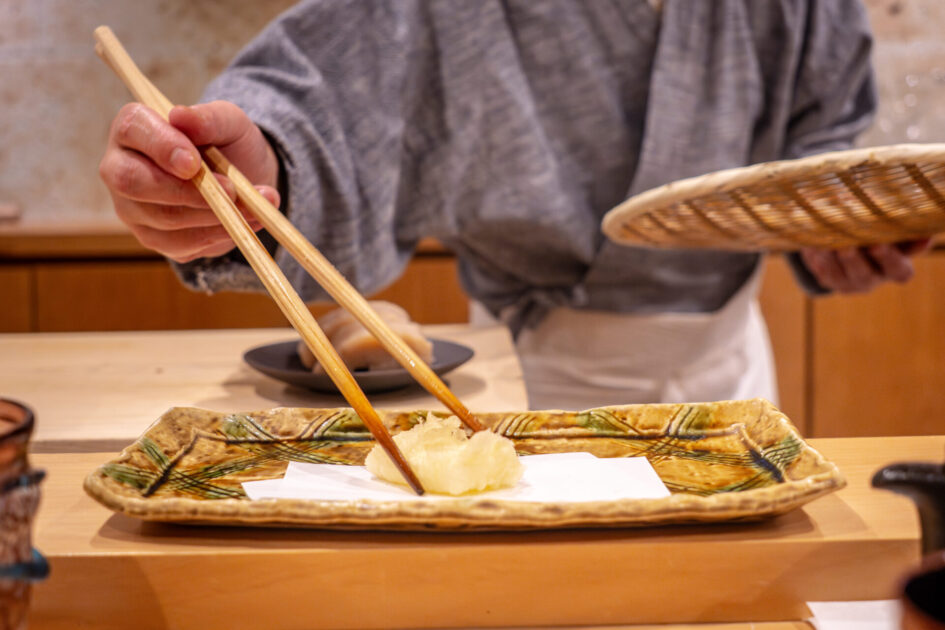CONTENTS
About Seirin
Concept
Nestled on a quiet street about 10 minutes on foot from Hamamatsu Station in Shizuoka, Japanese restaurant Seirin is, in the words of its chef, not just a “ryori-ya” (fine dining establishment), but a “tabemono-ya”—a humble place to truly eat. More than 98% of the ingredients are sourced locally from Shizuoka, and the menu shifts with the seasons: mountain vegetables and shellfish with nuta or tempura in spring, hamo (pike conger) in early summer, wild-caught eel from Lake Hamana in midsummer, and fugu (pufferfish) or game meats in the winter months.
Seasonal Dishes (Course Structure & Featured Ingredients)
-
Spring (Mountain vegetables, shellfish, nuta, and tempura)
A graceful assembly of the season’s delicacies: torigai (cockle), akagai (ark shell), mountain vegetables with nutadressing, assorted seasonal shellfish, and elegant tempura made with natural kuruma ebi (Japanese tiger prawn).Early Summer (Hamo)
The course revolves around hamo, served as yubiki (parboiled) and karaage (deep-fried). The flavors are light, clean, yet full of umami.Midsummer (Wild-caught eel from Lake Hamana)
The signature “Deshiko” brand eel is served shiroyaki-style (grilled without sauce), with crispy skin, rich fat, and deeply aromatic flesh—a truly memorable highlight.Autumn–Winter (Matsutake mushrooms, fugu, and game meats)
Dishes may include matsutake rice, tessa (fugu sashimi), grilled shirako (milt), karaage, and tecchiri (fugu hot pot), with game meats occasionally featured to reflect the bounty of the season.Soup, Rice, and Dessert
The meal closes with thoughtful finishing touches: handmade soba, sushi, ochazuke, and rice-based desserts or seasonal fruits, carefully crafted to leave a lasting impression.Philosophy of Broth
Driven by a belief in using fresh broth (“nama dashi”) over dried ingredients, every dish begins with dashi made from fresh seafood and is finished with only salt. This method draws out the natural umami of each ingredient. Inspired by Edo-period culinary texts and traditional regional techniques, this approach is made possible by the abundance of fresh seafood from Suruga Bay.
Chef Atsunari Hasebe
Born in 1989, Chef Atsunari Hasebe began his culinary journey at 19. He trained under the renowned Japanese restaurant Seroku in Tokyo starting in 2013, then returned to his hometown to open Seirin in Hamamatsu in October 2018.
Captivated by local ingredients like the seafood of Suruga Bay and wild mountain vegetables of Hamamatsu, he even forages his own produce. Eschewing dried ingredients, he developed his unique “nama dashi” style to bring out the inherent flavor of each component. His insistence on calling Seirin a “tabemono-ya” reflects his personal philosophy and deep connection to the region.
Despite facing challenges from climate change and sourcing difficulties, he maintains high standards, stating, “If the ingredients aren’t good enough, I simply won’t open.” His food doesn’t aim to please everyone—he embraces the niche, creating dishes for connoisseurs.
Expanding his vision, he has opened sister restaurants in unagi, yakitori, and yakiniku styles to build platforms where talented chefs across Japan can shine. From Hamamatsu to the rest of the country, he continues his mission to elevate both ingredients and culinary artisans.
Recognition
Located in Hamamatsu, Shizuoka, Seirin has received Tabelog Awards:
-
Gold in 2023 and 2024
-
Silver in 2022 and 2025
This places it among the top-rated restaurants out of roughly 850,000 in Japan.
It was also selected for Tabelog’s Top 100 Japanese Restaurants EAST in both 2023 and 2025, cementing its place as one of the leading establishments in the Tokai and Kanto regions.

Dining Prelude
Exterior & Entrance
Tucked away from Hamamatsu’s bustling center, Seirin’s exterior is understated yet refined. A lustrous wooden sliding door and a crisp white noren curtain adorned with a vivid red sea bream signal its identity with quiet confidence.
At night, lantern-style lighting casts a warm glow over the wood-carved nameplate. White plaster walls and clean tiles give the façade a sense of elegant minimalism, naturally heightening the anticipation for what lies within.
Though discreet, the red sea bream hints at the restaurant’s soul: a reverent showcase of seasonal fish from Shizuoka, expressed one plate at a time.
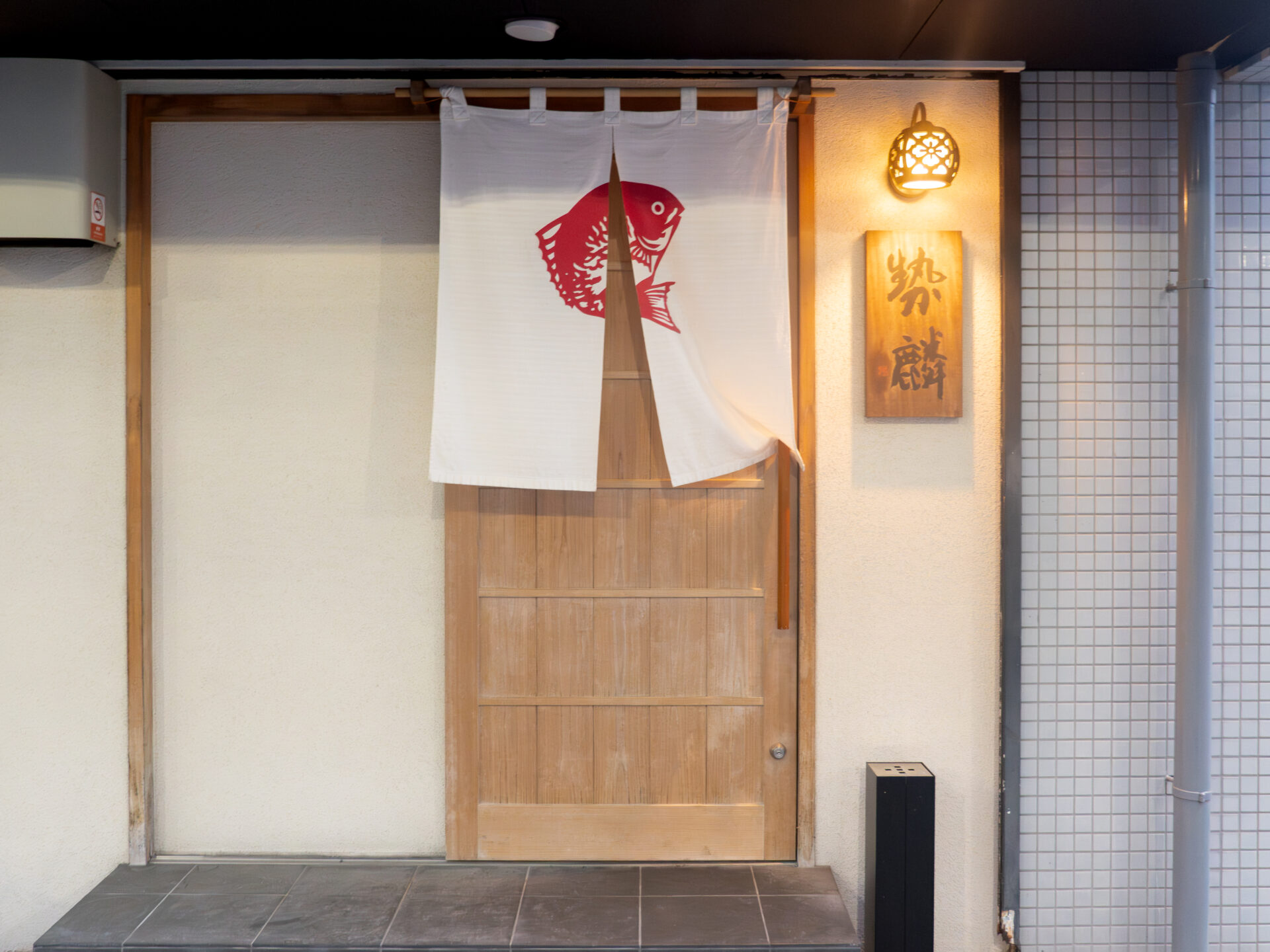
Dining Space
Stepping inside, guests are enveloped in a serene atmosphere that is both taut with focus and somehow deeply calming. The centerpiece: a counter crafted from a single slab of ginkgo wood, where diners can observe every move of the chef—a true culinary stage for both the eyes and the palate.
The stone walls, reminiscent of Ryukyu limestone, emit a soft warmth. At the center, the Zen calligraphy “Ichi-i kanzushi” serves as a quiet declaration of Chef Hasebe’s philosophy: to stay true to one’s purpose.
Lighting is subdued, softly illuminating only the counter, casting elegant shadows over the plates. Music is minimal or absent, allowing full immersion in the dining experience.
Behind the counter, shelves neatly display wine and seasonal sake. The design, rich in natural materials like wood and stone, resonates with the nature of Shizuoka. It’s a space that offers mental clarity—a “blank canvas” for appreciating food.
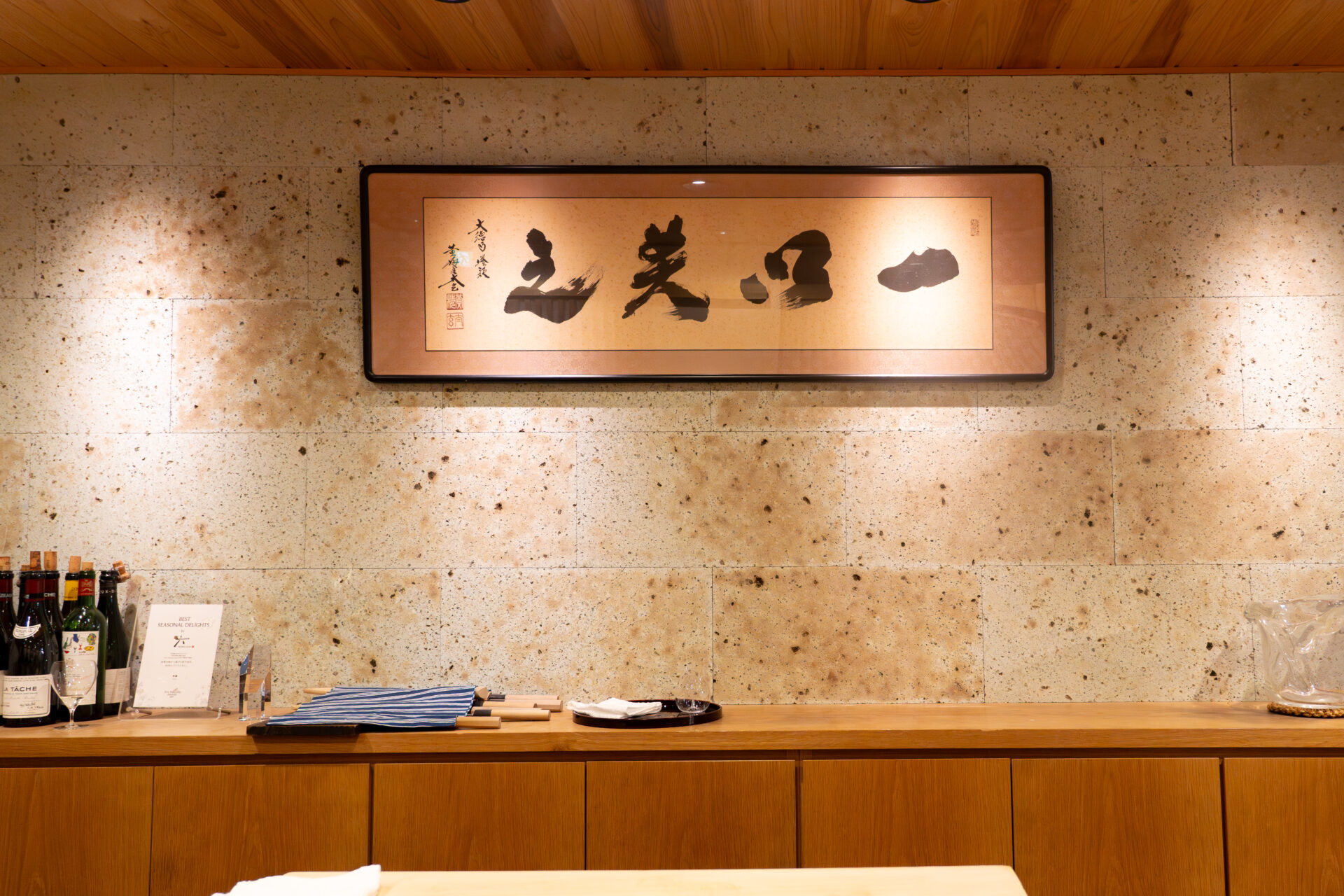
Menu Presentation
Before the course began, Chef Hasebe presented a wooden box—a stage behind the curtain, filled with the seasonal ingredients to be featured that day. Crafted from fragrant hinoki cypress, the box itself was beautiful, but its contents were even more striking: a lineup of freshly harvested treasures from the mountains and seas of Shizuoka, each in impeccable condition.
There were plump, dewy new onions, extra-thick asparagus spears firm from base to tip, and tara-no-me (angelica tree shoots) stretching skyward—vivid symbols of spring’s arrival. Further back, gleaming kuruma ebi, cuts of delicate white fish, and scallops were nestled neatly—soon to take center stage in the tempura course.
This moment marked the prologue to Seirin’s culinary performance. Before a single dish was served, the thoughtful presentation signaled a deep respect for ingredients and an exacting level of preparation. Each item didn’t merely sit in the box—they stood ready, like leading actors poised for their cue, polished and primed.
The course to follow—an omakase of spring tempura—was shaped by these ingredients. Witnessing their transformation, one by one, was not just a pleasure but a defining feature of the Seirin experience.
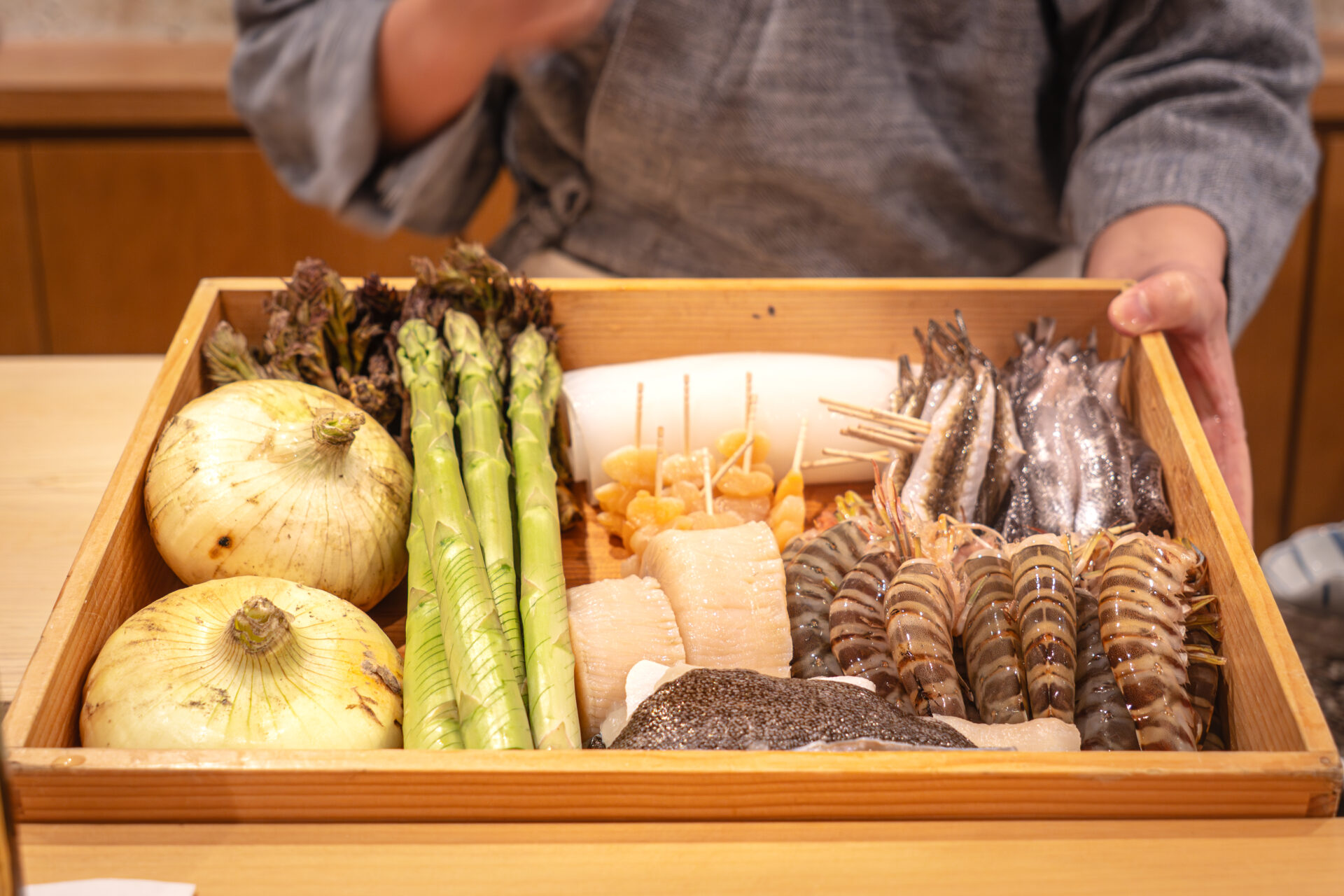
Starter Drink
The meal began with a crisp, chilled Sapporo Black Label.
Its refreshing bite signaled the start of a deeply focused culinary journey, perfectly complementing the tranquil atmosphere of the counter.
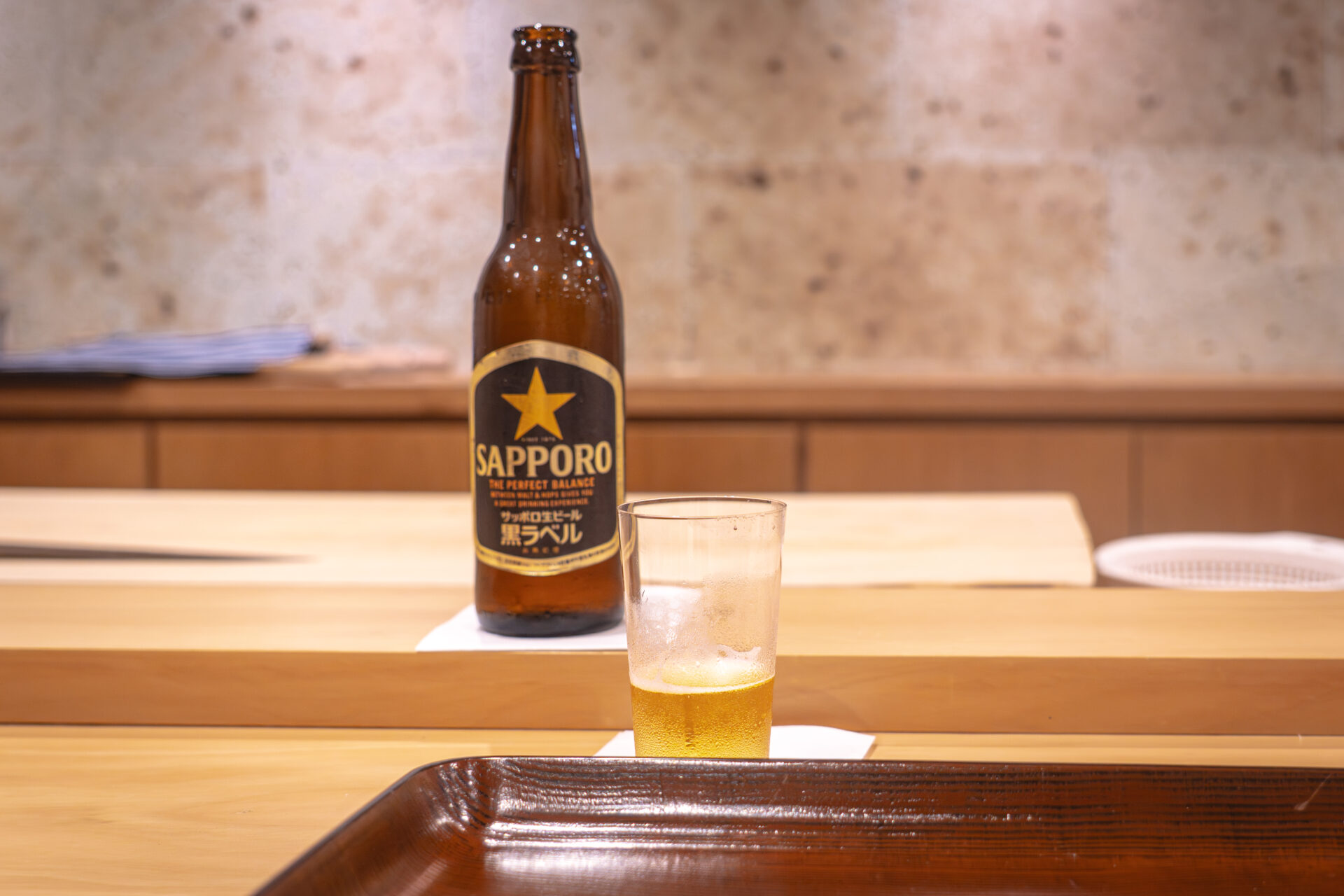
Dishes Tasted
White Asparagus with House-Cured Karasumi
Among the early highlights of the tempura-centered course was this strikingly minimal yet impactful dish: freshly harvested white asparagus, simply adorned with finely grated house-made karasumi (dried mullet roe). The restrained presentation only enhanced the bold presence of each ingredient. The asparagus, crisp and sweet, was elevated by the briny richness of the karasumi, creating a perfect harmony that spoke volumes in silence.
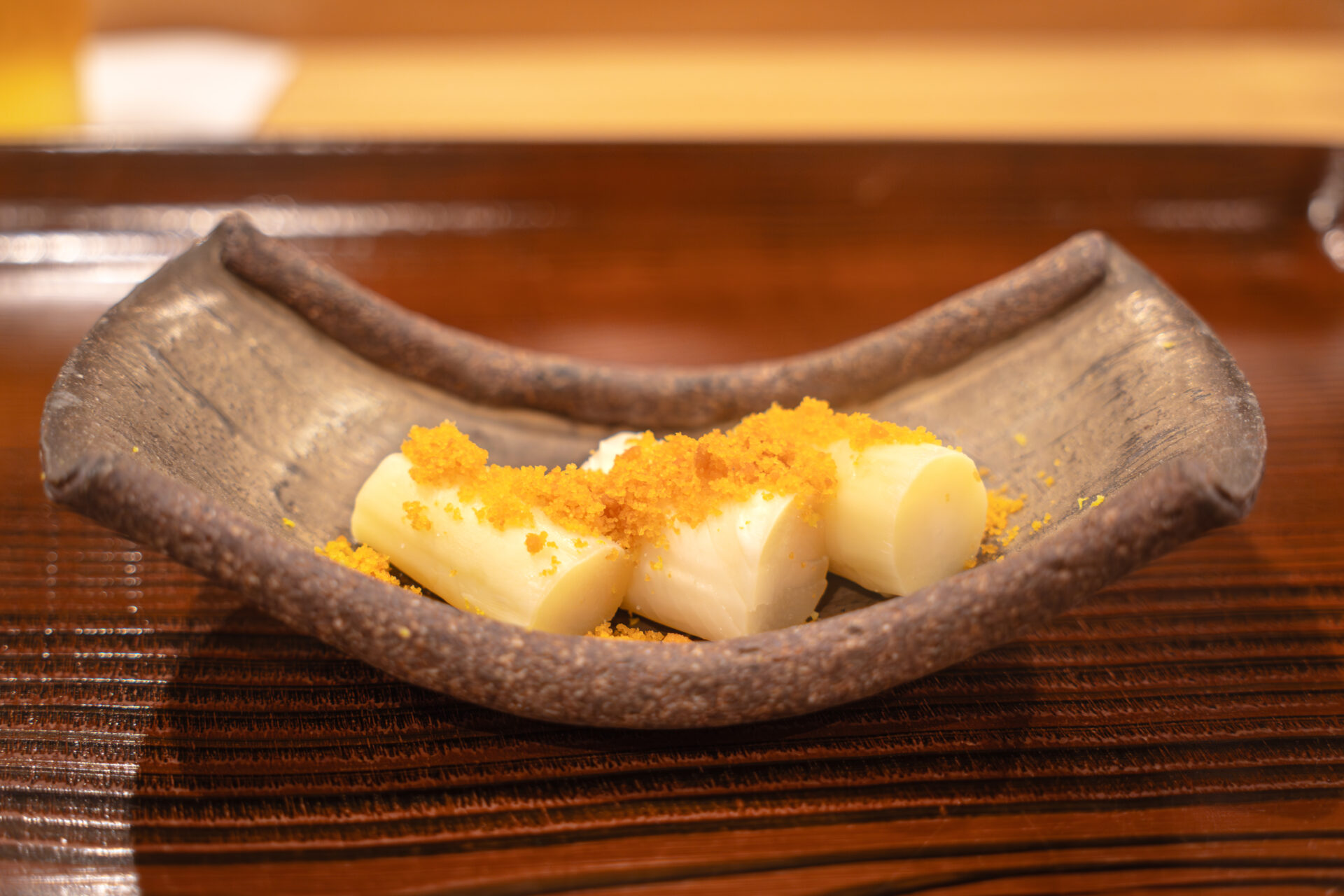
Sashimi of Hamamatsu Akagai & Torigai
The akagai (ark shell) was a striking sight with its thick, deep reddish flesh. In the mouth, it offered a pleasing elasticity, and as it was slowly chewed, layers of sweetness and briny aroma began to unfold. Most memorable was how the subtle flavors of the seaweed and kelp the shellfish naturally consume in the wild had gently transferred into the flesh itself. With just one bite, you could sense the richness of Hamamatsu’s coastal waters.
The torigai (cockle), on the other hand, was equally robust in texture but stood out for its tender, almost plump mouthfeel. Expertly cooked with a gentle touch, it revealed a graceful sweetness and refined umami. Free of any off-flavors, it lingered with a pure, clean finish.
Without relying on unnecessary embellishments, the dish allowed the innate beauty of the ingredients to shine through. This minimalist approach—so characteristic of Seirin—delivered the shellfish’s “memory of the sea” in its purest form. A truly memorable sashimi course.
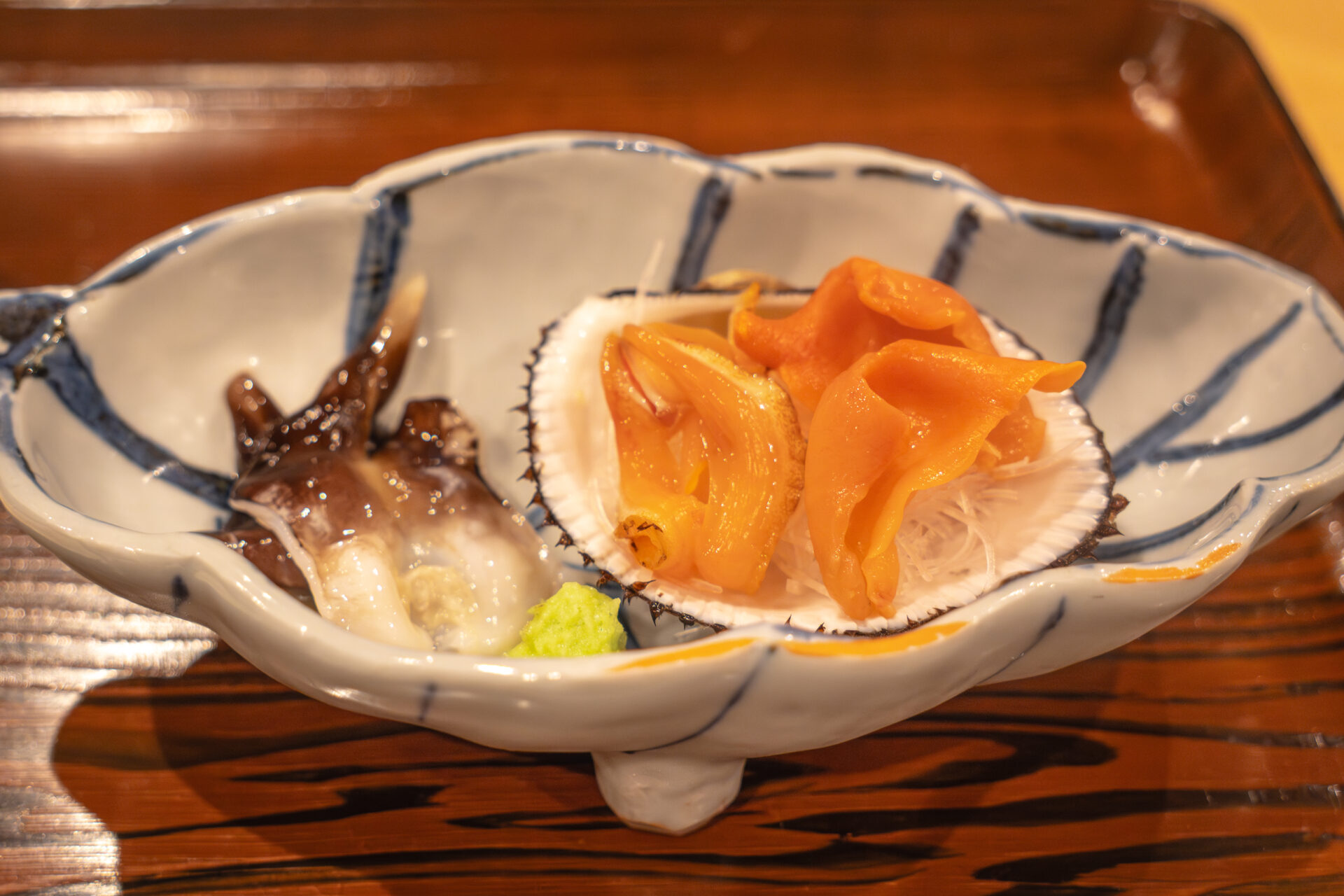
Specialty “Mochi-Gatsuo” with Bloodline Broth
A true local treasure, mochi-gatsuo—a term reserved for only the freshest early-season katsuo (bonito) caught off the Shizuoka coast—made its appearance. Its namesake texture did not disappoint: the flesh was tender, almost elastic, and clung softly to the knife. Upon tasting, an intense, layered umami flooded the palate. Its fine muscle fibers and superior fat quality completely defied the common notion of katsuo as a “light” fish—this was dense, rich, and deeply satisfying.
Then came an extraordinary surprise: the bloodline broth, offered by the chef with a quiet, “Would you like to try this?”
Made by simmering the katsuo’s blood-rich sections with nothing but tap water, this broth was revelatory. Far from fishy, it was instead profoundly savory with a subtle sweetness and a “raw” aroma that bypassed the usual notes of dried bonito. The purity and depth of flavor could only be achieved using fish in peak condition. As the chef noted, “You can only serve this when the fish is absolutely perfect.”
Together, the sashimi and the broth offered a full, multidimensional expression of katsuo—a testament to the chef’s sensitivity and technical precision. It was an unforgettable pairing that showcased Seirin’s depth of craftsmanship.
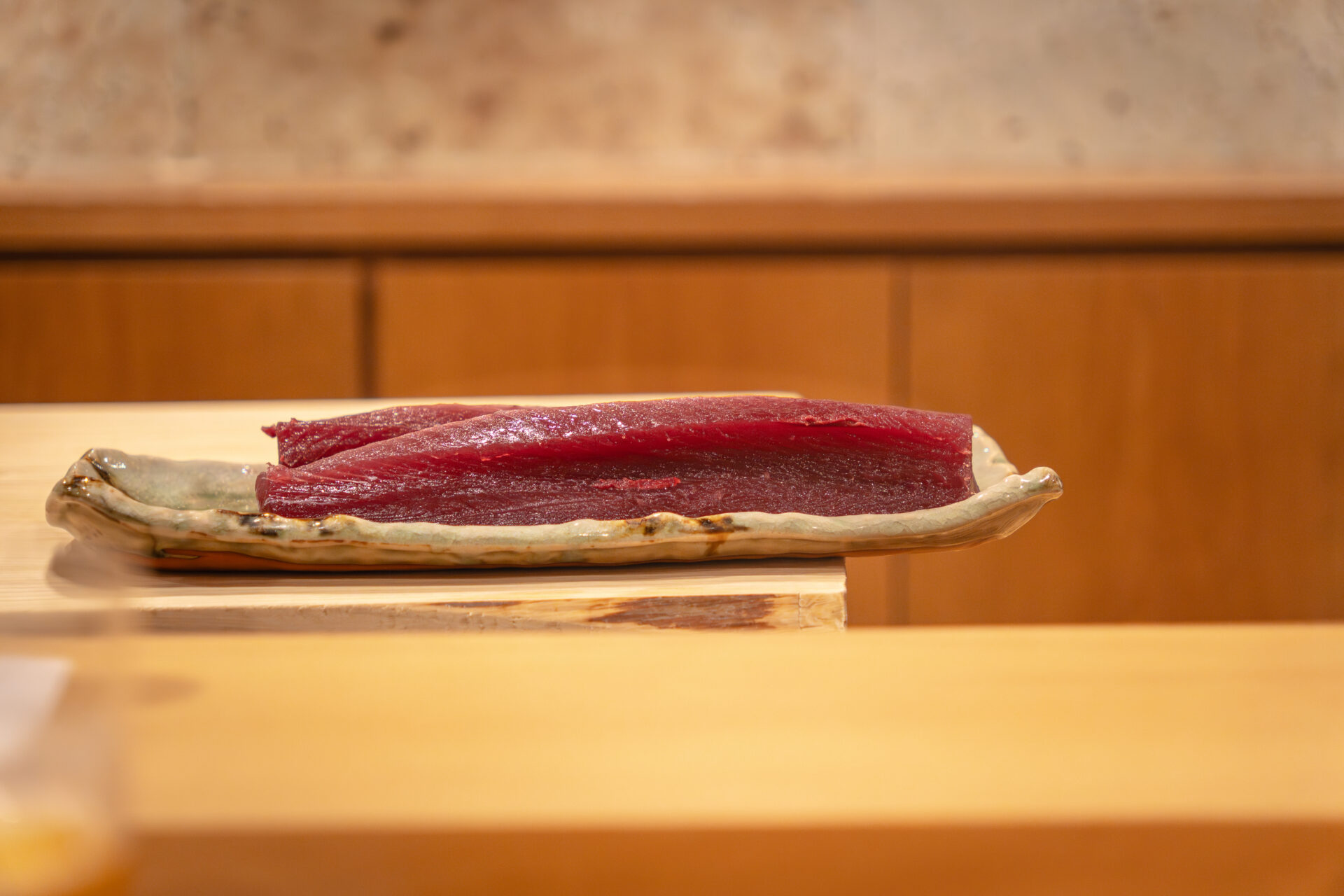
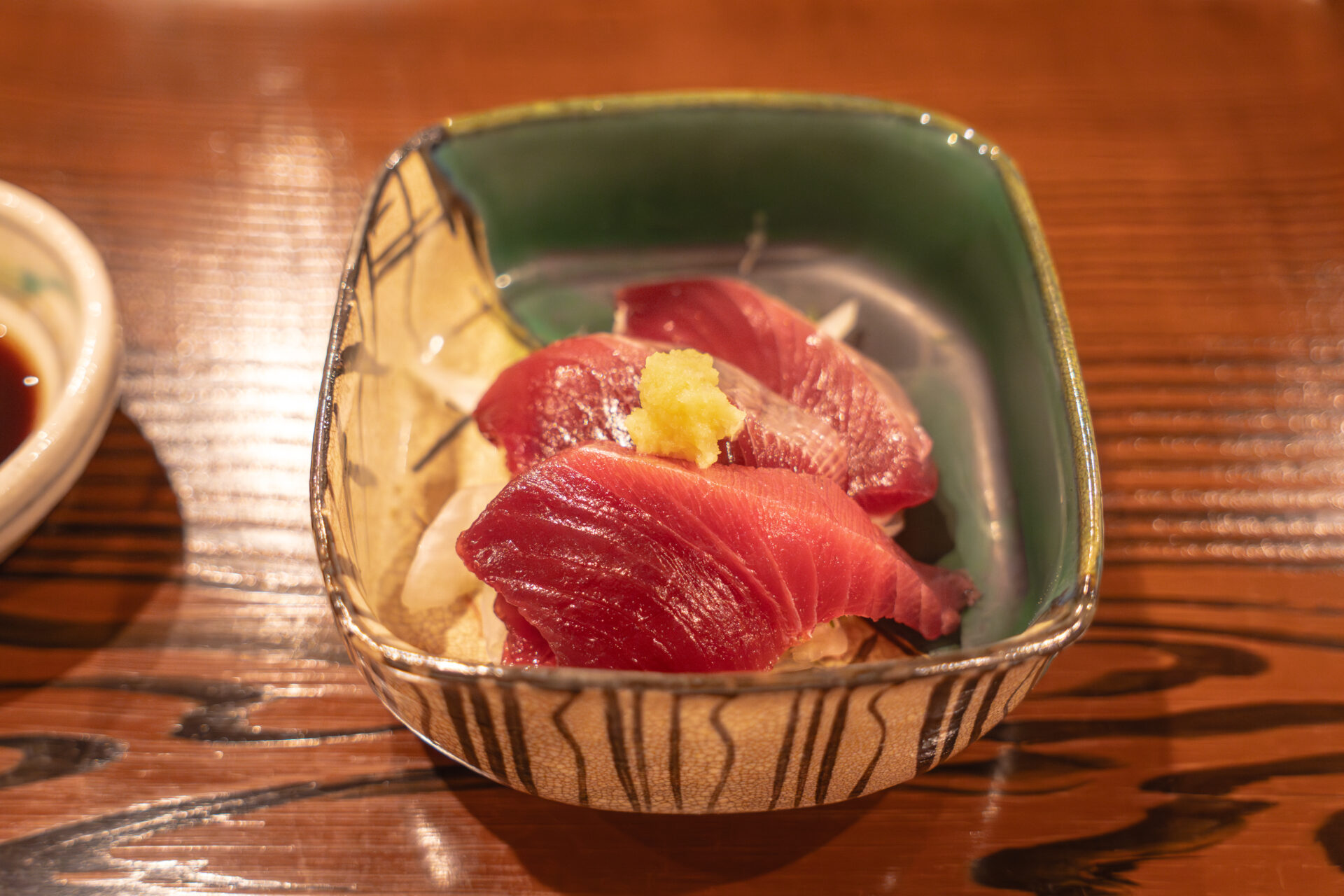
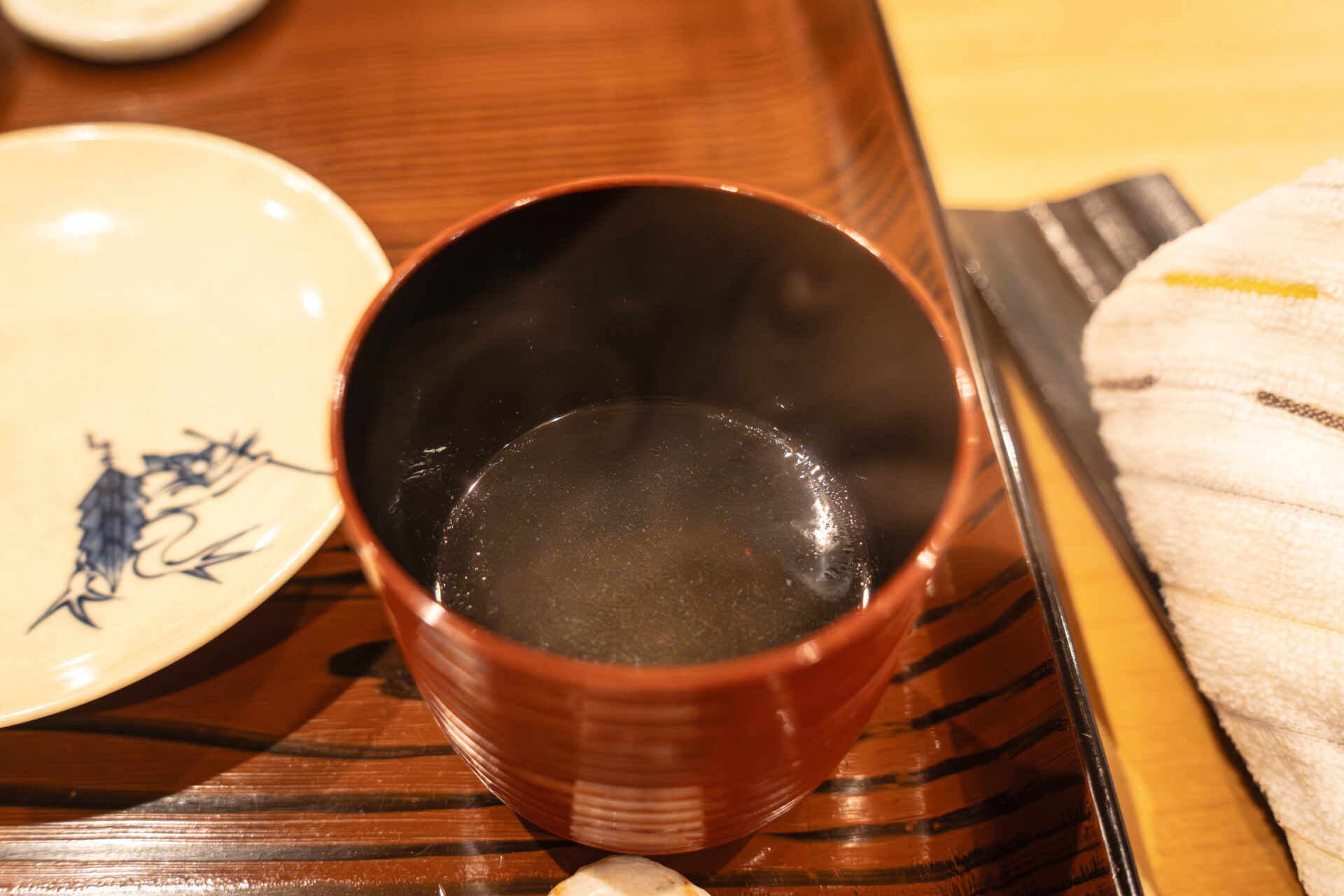
“Kuro Tefu” Junmai Daiginjo
Sake pairing was entrusted to the chef, who selected a spring limited-edition: “Kuro Tefu”, a junmai daiginjo from Kokken Brewery in Minamiaizu, Fukushima (polished to 40%). Named after the Japanese emperor butterfly (Omurasaki) native to the region, it opened with a graceful ginjo aroma. On the palate, it was soft and rounded with gentle sweetness, finishing with a clean, crystalline aftertaste that beautifully complemented the light oil of the tempura.
More than a drink, it felt like a poetic reflection of the season.
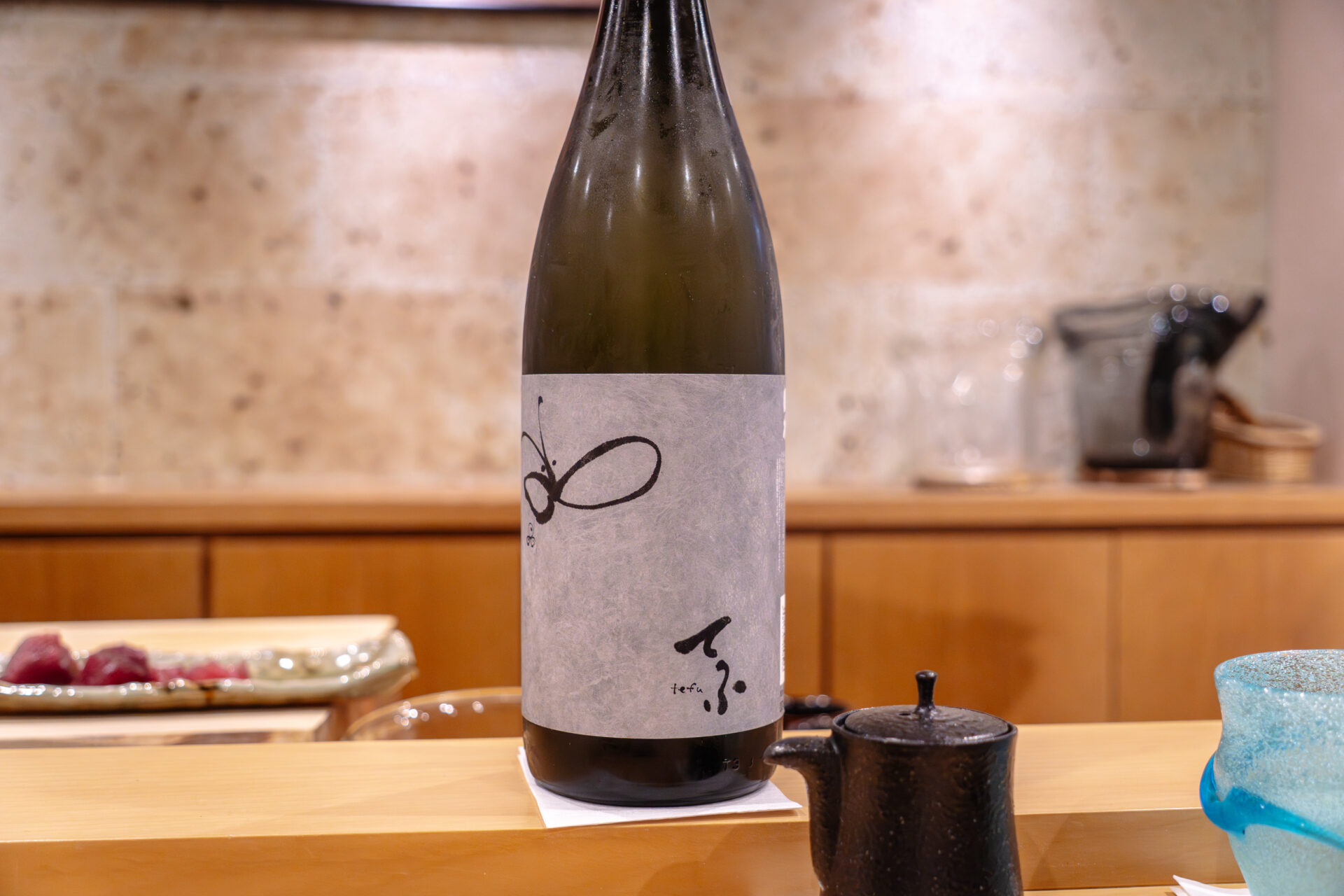
Scorpaena (Okoze) Stewed in Suppon Style
The final savory course was a stewed dish of okoze (scorpaena), simmered in a style reminiscent of suppon (soft-shell turtle). The broth used only water and soy sauce—an exercise in restraint that allowed the fish’s full character to shine.
From the first sip, the broth revealed a transparent yet profound umami, with gentle fat and toasted bone essence unfolding in quiet waves. Despite the depth, the flavor remained feather-light, soaking gently into the body. The natural richness akin to suppon married beautifully with the delicate, supple flavor unique to okoze, creating a bowl that radiated quiet strength—serene on the surface, yet unwavering in its core.
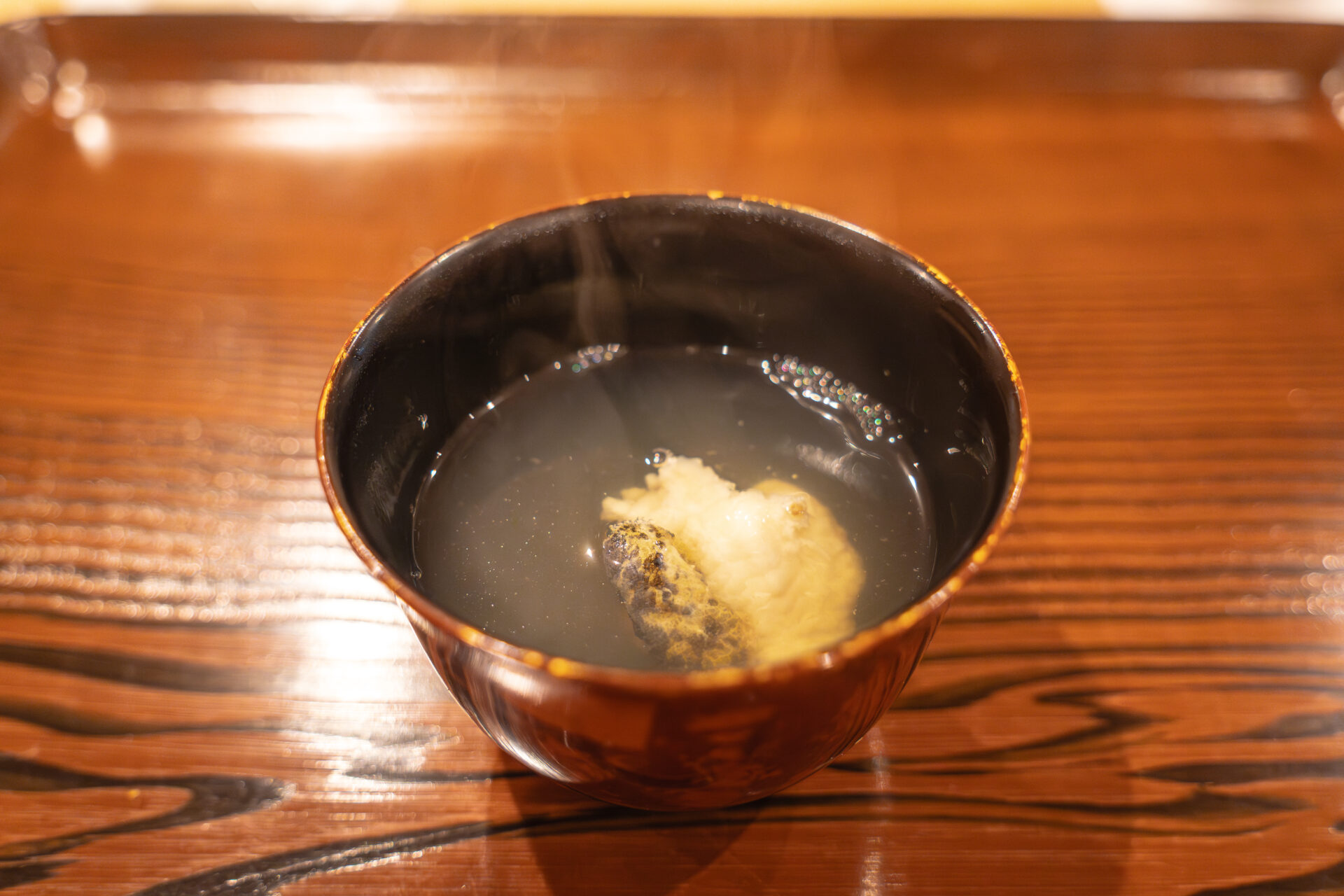
The Tempura Journey Begins — Kuruma Ebi Two Ways
The tempura segment of the course began with a stunning presentation: two pieces of kuruma ebi (Japanese tiger prawn) tempura, each prepared with a different degree of heat—a signature detail that immediately reflected Seirin’s meticulous craftsmanship.
The first prawn was lightly cooked, retaining a translucent, almost raw texture beneath the crisp batter. Upon biting in, a tender, springy resilience gave way to an outpouring of sweet, oceanic flavor. This gentle cooking preserved the shrimp’s innate aroma and rich umami, highlighting the purity of its “raw” essence.
The second piece was cooked through more thoroughly. The result: a firmer, snappier bite with a deeply aromatic finish. The batter was fine, light, and delicately crisp—never overpowering the shrimp’s subtle flavors.
This thoughtful contrast showcased the full expressive range of a single ingredient. From the outset, it was clear: tempura at Seirin is not merely “fried food,” but a carefully constructed narrative told through technique, timing, and respect for the ingredient.
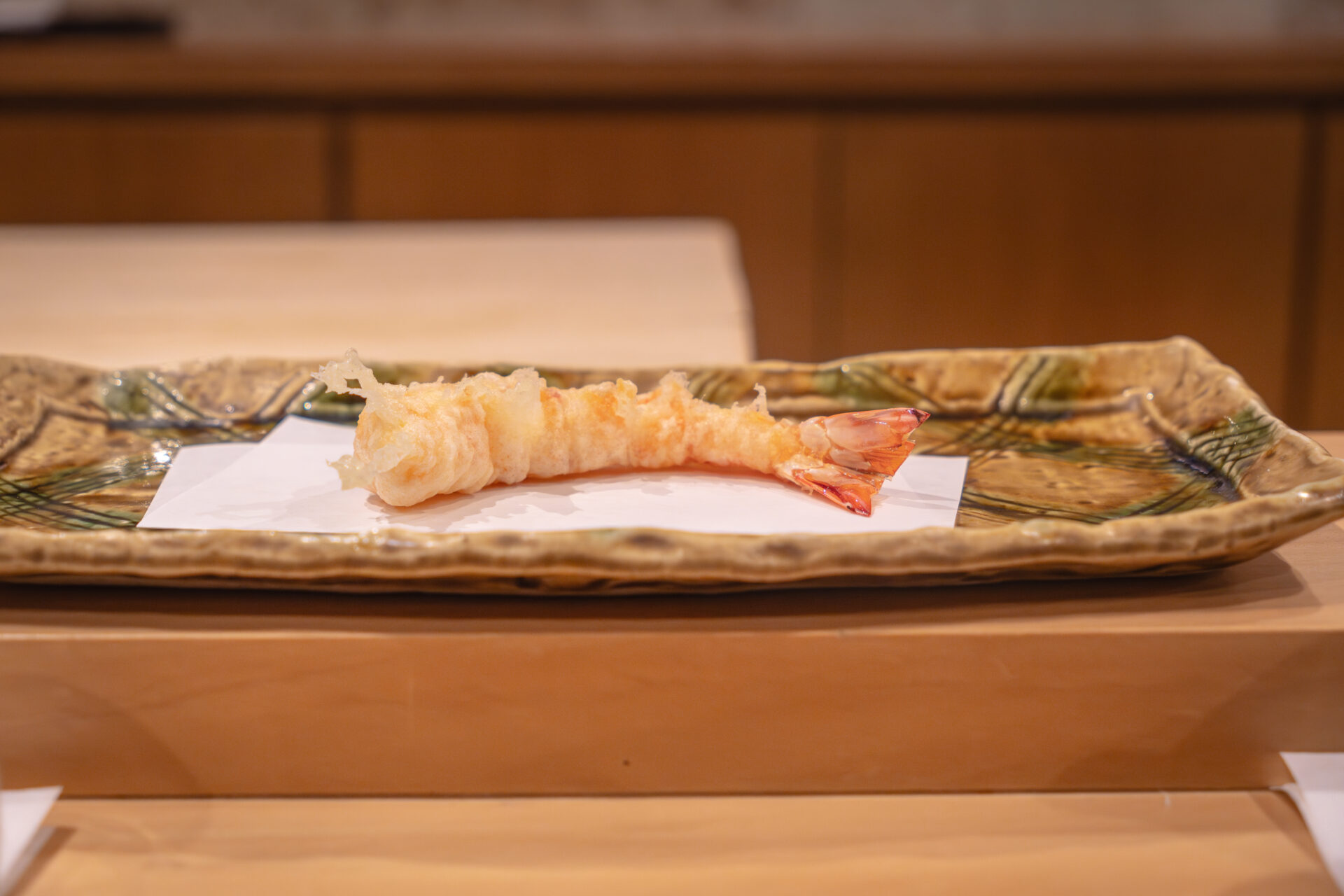
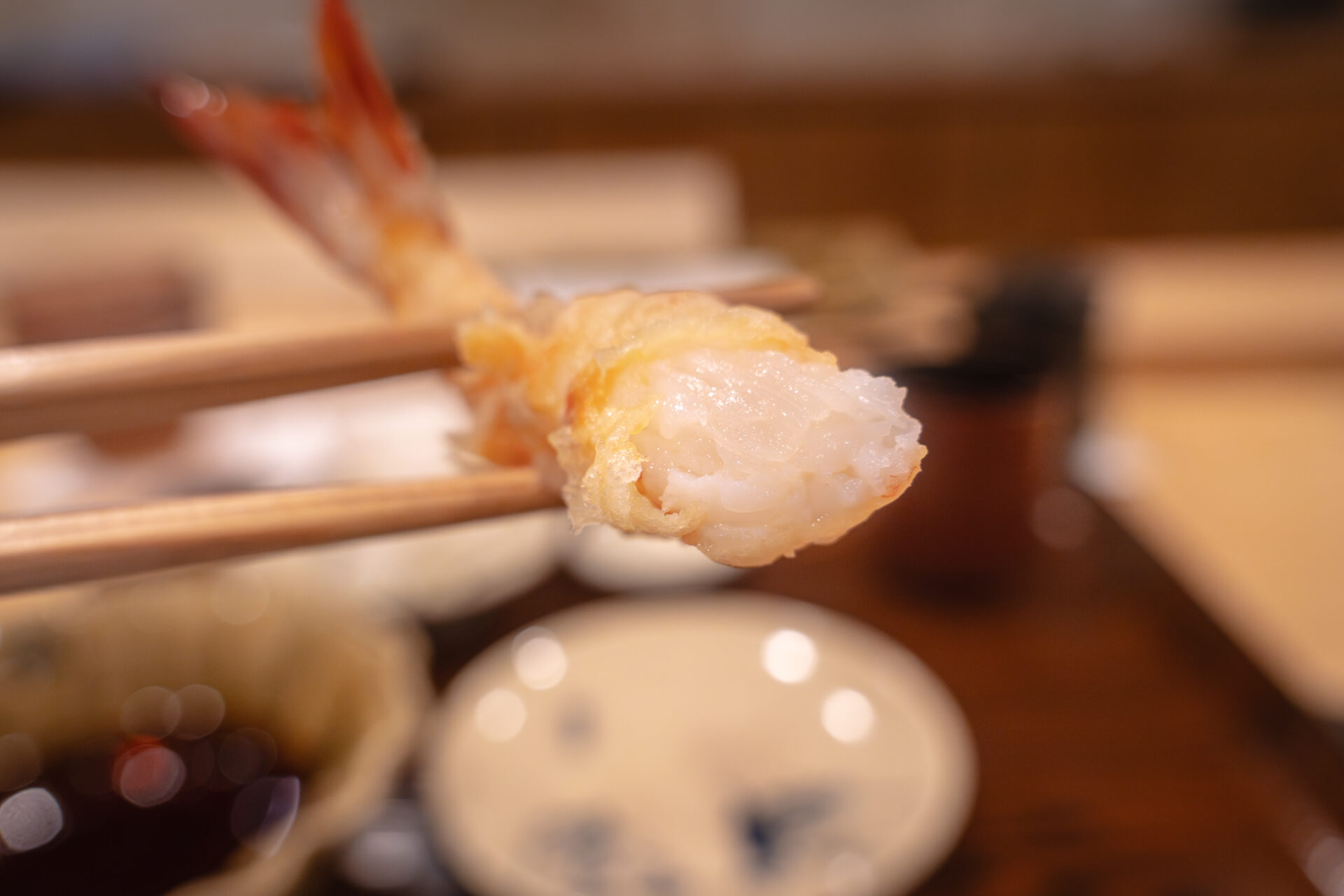
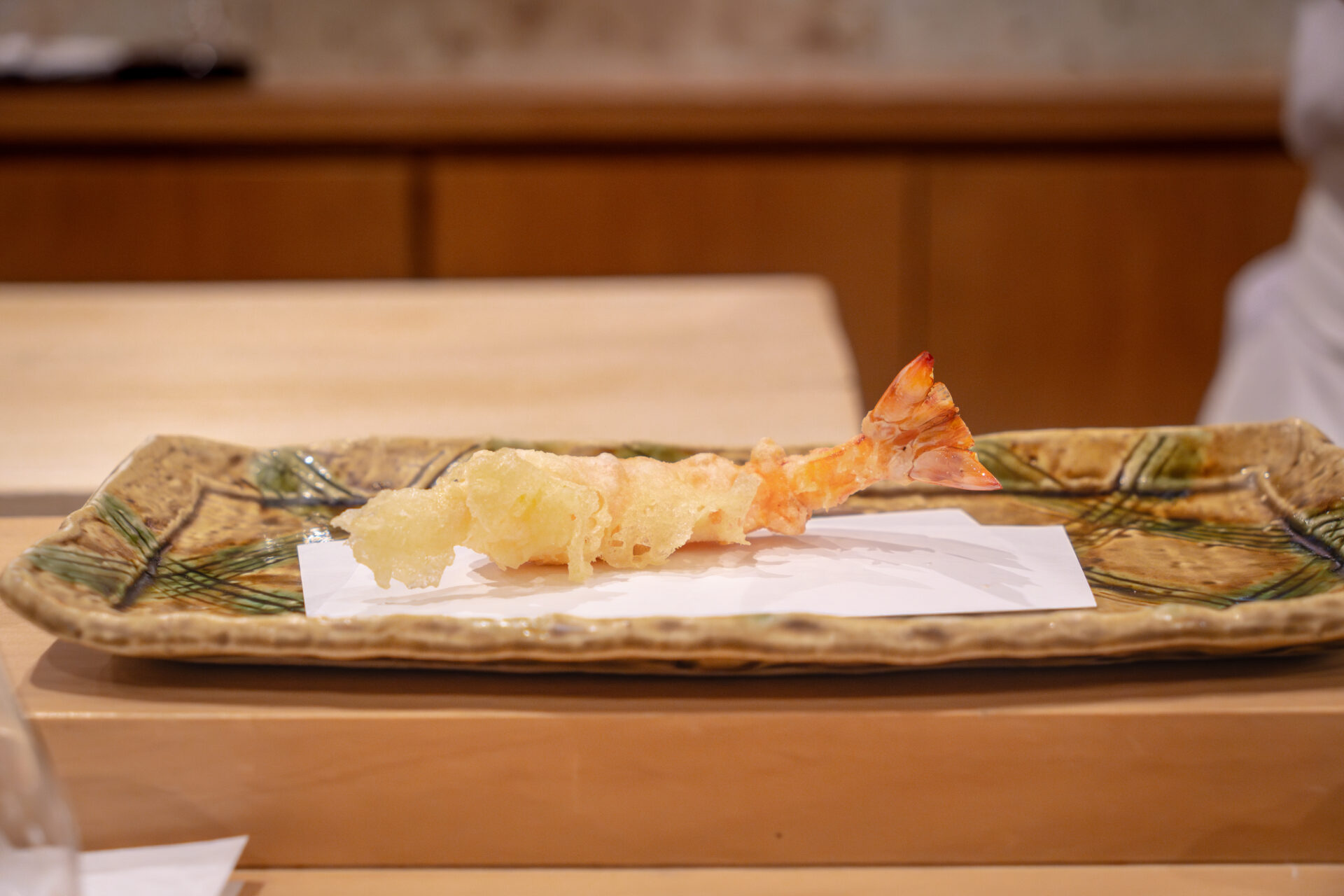
Asparagus
Next came asparagus tempura, treated with extraordinary sensitivity. Rather than frying the stalk whole, it was divided into tip and stem, each prepared separately to maximize its qualities.
The stem, substantial in girth, was thoroughly cooked to the center. When bitten into, it released a rush of sweetness and moisture. The batter was slightly thicker here, echoing the strength of the stalk’s texture and adding satisfying weight.
The tip, by contrast, was dressed in an ultra-thin batter. It was swiftly fried to preserve the asparagus’ fresh, green aroma. Upon biting, a crisp texture yielded to a fleeting bitterness reminiscent of young leaves—gentle and evocative.
This dish demonstrated a profound understanding of vegetables, from heat control to batter density to aromatic balance. Every decision felt deliberate, the work of a chef in deep conversation with his ingredients.
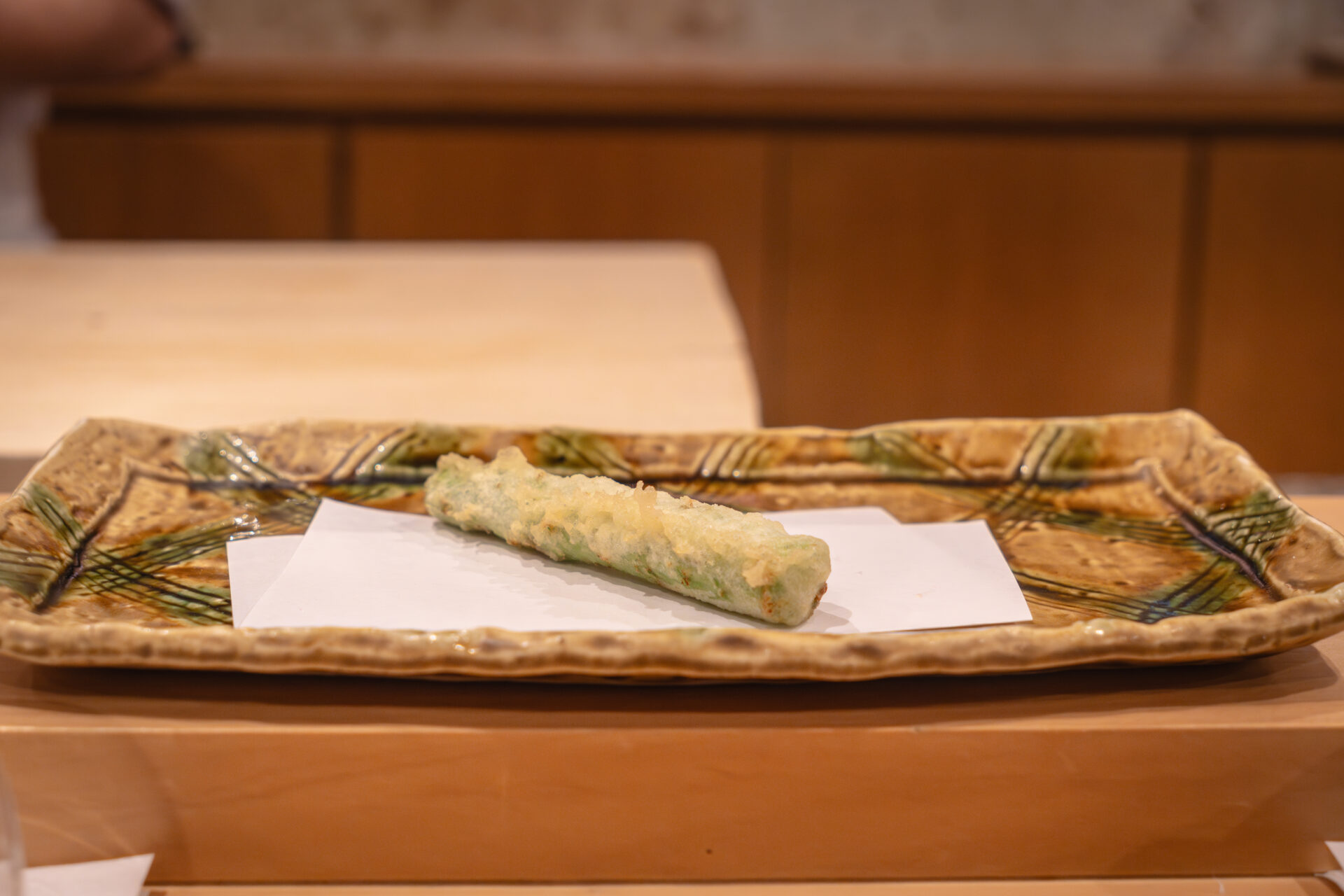
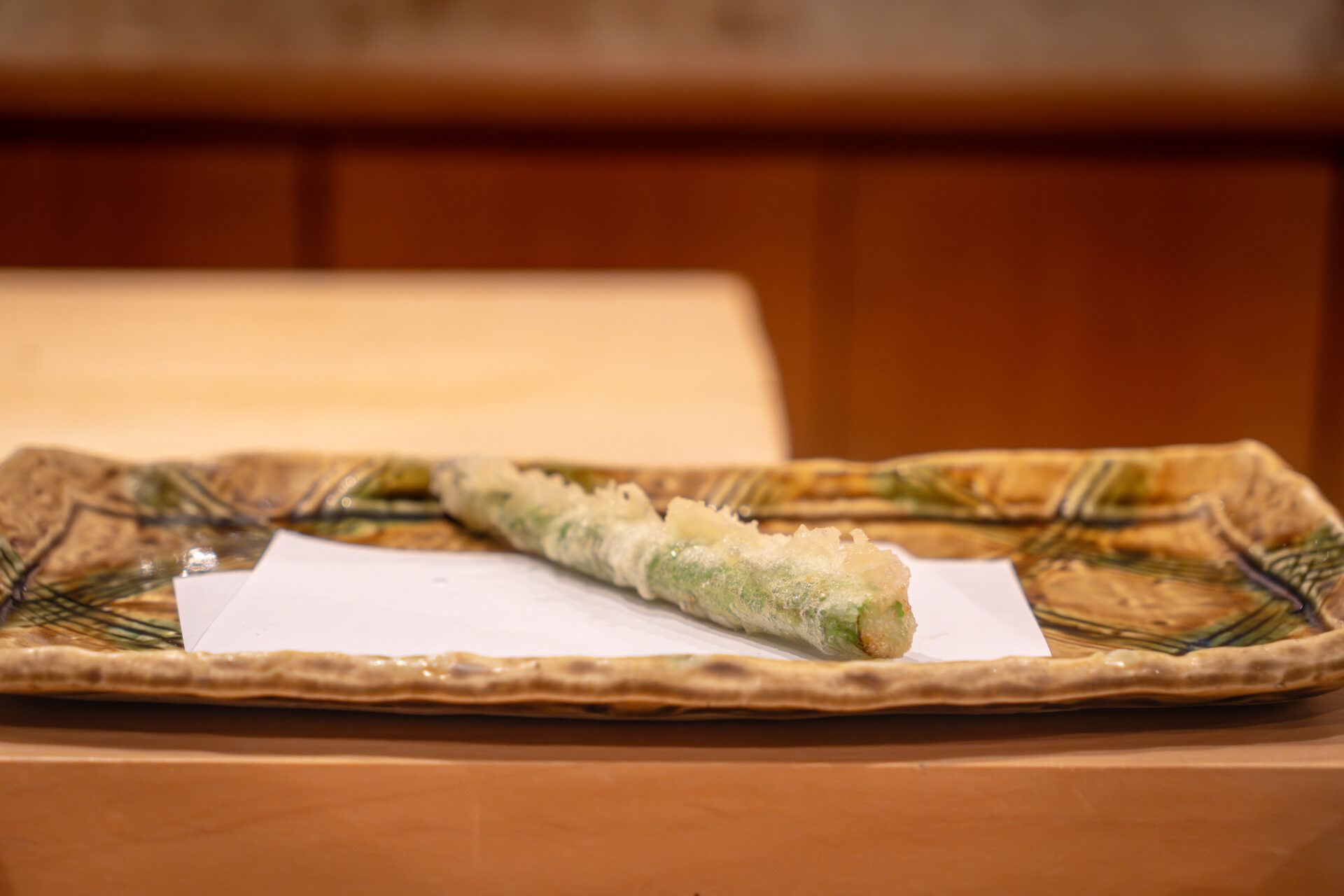
Nabeshima Junmai Ginjo Yamada Nishiki
(Fukuchiyo Shuzo, Saga Prefecture)
This sake paired with the tempura was a Junmai Ginjo made with Yamada Nishiki rice. It featured a full-bodied aroma, soft sweetness, and a clean, crisp finish—an ideal match for the delicate character of the tempura.
True to Nabeshima’s signature style, its floral ginjo bouquet lifted the toasted notes of the batter without overwhelming the food. As the temperature of the glass rose slightly, the rounded flavor of the rice deepened, revealing a sake of complexity and elegance—an excellent companion to the meal’s subtleties.
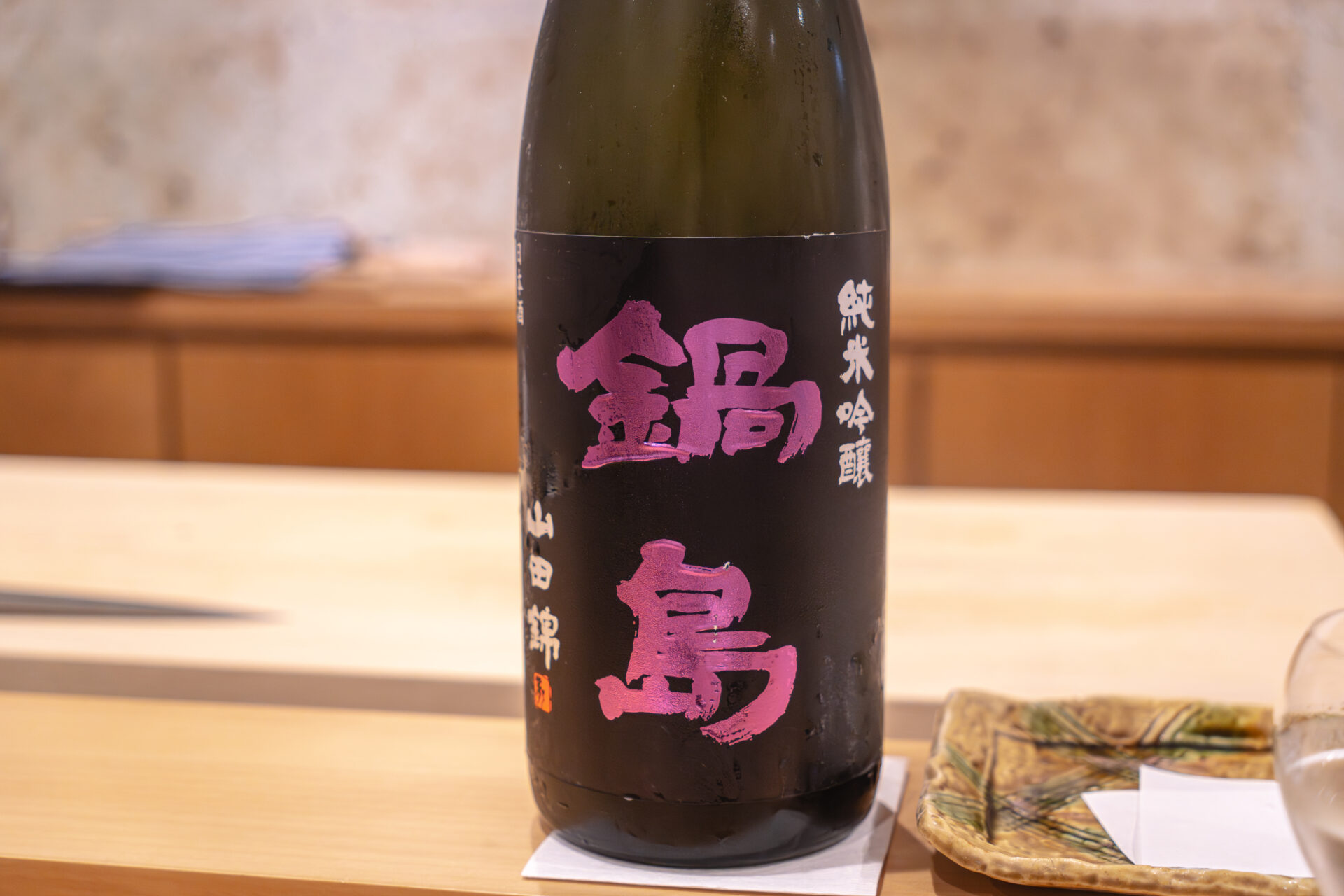
Megoji (Flathead)
Then came megoji tempura, a white-fleshed fish prized in Edo-style tempura yet surprisingly rare outside the capital. At Seirin, it was presented with its tail arched gracefully—a nod to the attention paid to form as well as flavor.
The batter was feather-light, and the fish yielded effortlessly to chopsticks. On the palate, its delicate sweetness and faint ocean aroma unfolded gently. The flesh was moist but not oily, its mild umami gracefully complemented by the fragrance of the batter. A quiet, elegant dish that lingered with poise.
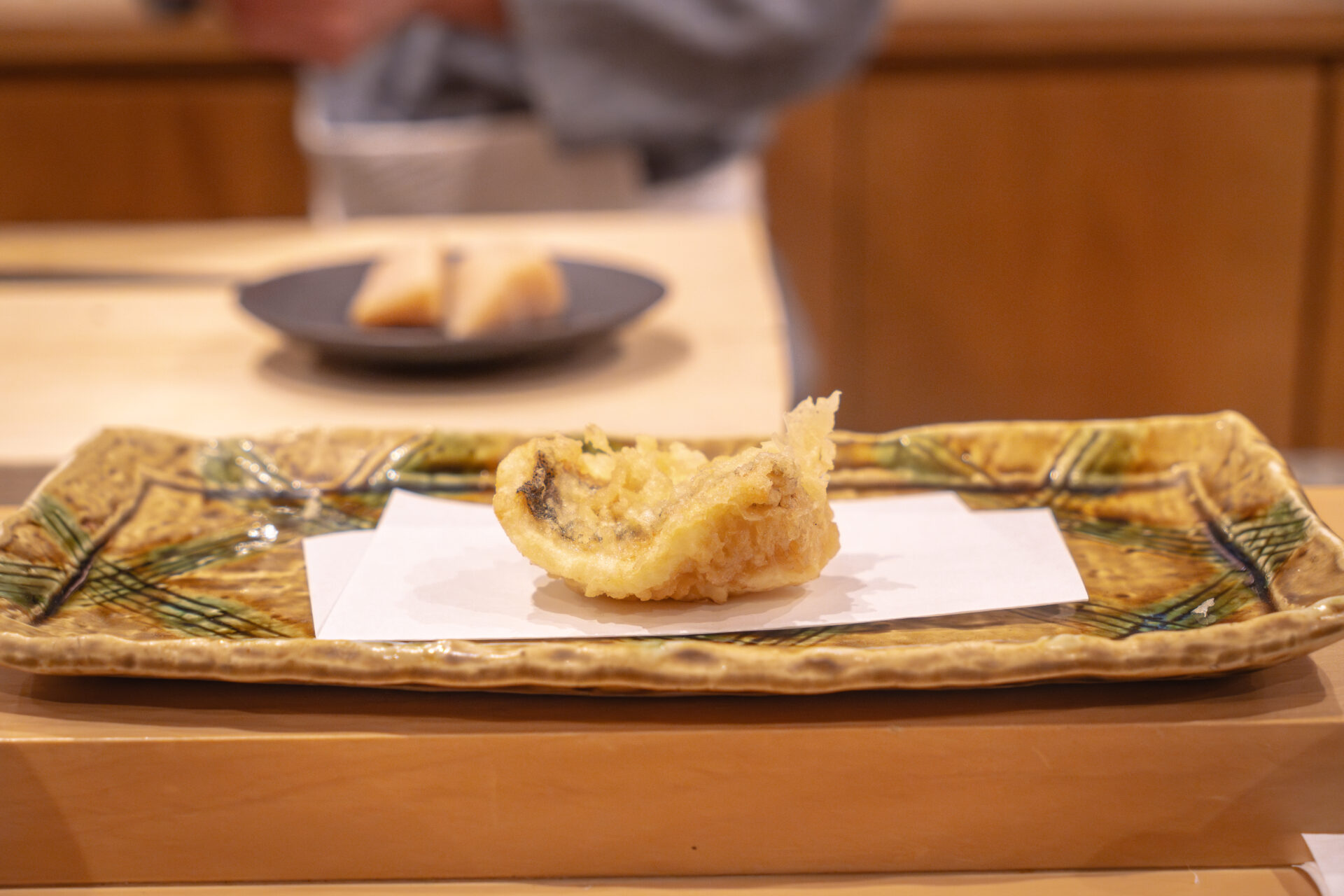
Aori Ika (Bigfin Reef Squid)
Midway through the tempura course, aori ika made a memorable appearance. Its glossy white flesh shimmered faintly through the batter, arriving on the plate freshly fried and glistening.
With a single bite, the squid revealed its soft, elastic texture and natural stickiness. As it was chewed, its sweetness and umami gently bloomed. The heat had permeated just enough to draw out its subtle essence without muting it—a masterful touch.
The batter was ultra-thin, enhancing the squid’s profile with a whisper of crispness and toast, never obscuring its nature. It needed no salt or dipping sauce; the squid alone was enough to captivate the palate.
This was a dish that reminded you: Seirin’s tempura is not merely technical mastery—it is born from deep respect for the ingredient itself.
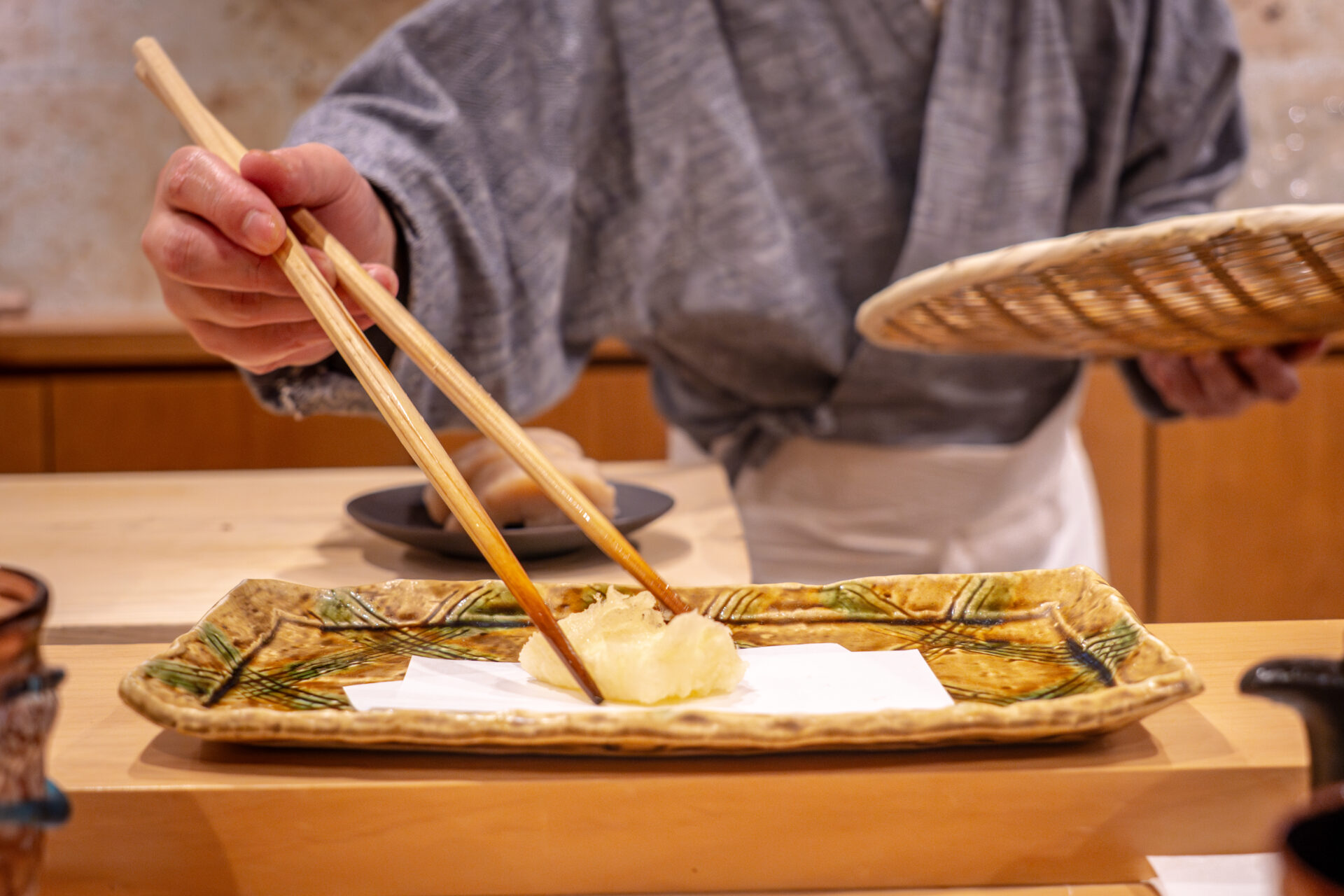
Kobashira (Scallop Adductor Muscles)
Next came kobashira tempura, gently threaded on a skewer. Even before tasting, the delicacy of the preparation was evident in its presentation.
In the mouth, the small scallops were tender and soft, unfolding with a slow-building sweetness and clean shellfish umami. The batter, again, was whisper-thin—providing just enough texture and roasted aroma to support the kobashira without overshadowing it.
Unlike when grilled, frying allowed the kobashira’s gentle, pristine flavor to blossom fully. It was a nuanced dish, showcasing how even the lightest touch can yield the richest reward when the ingredient is truly understood.
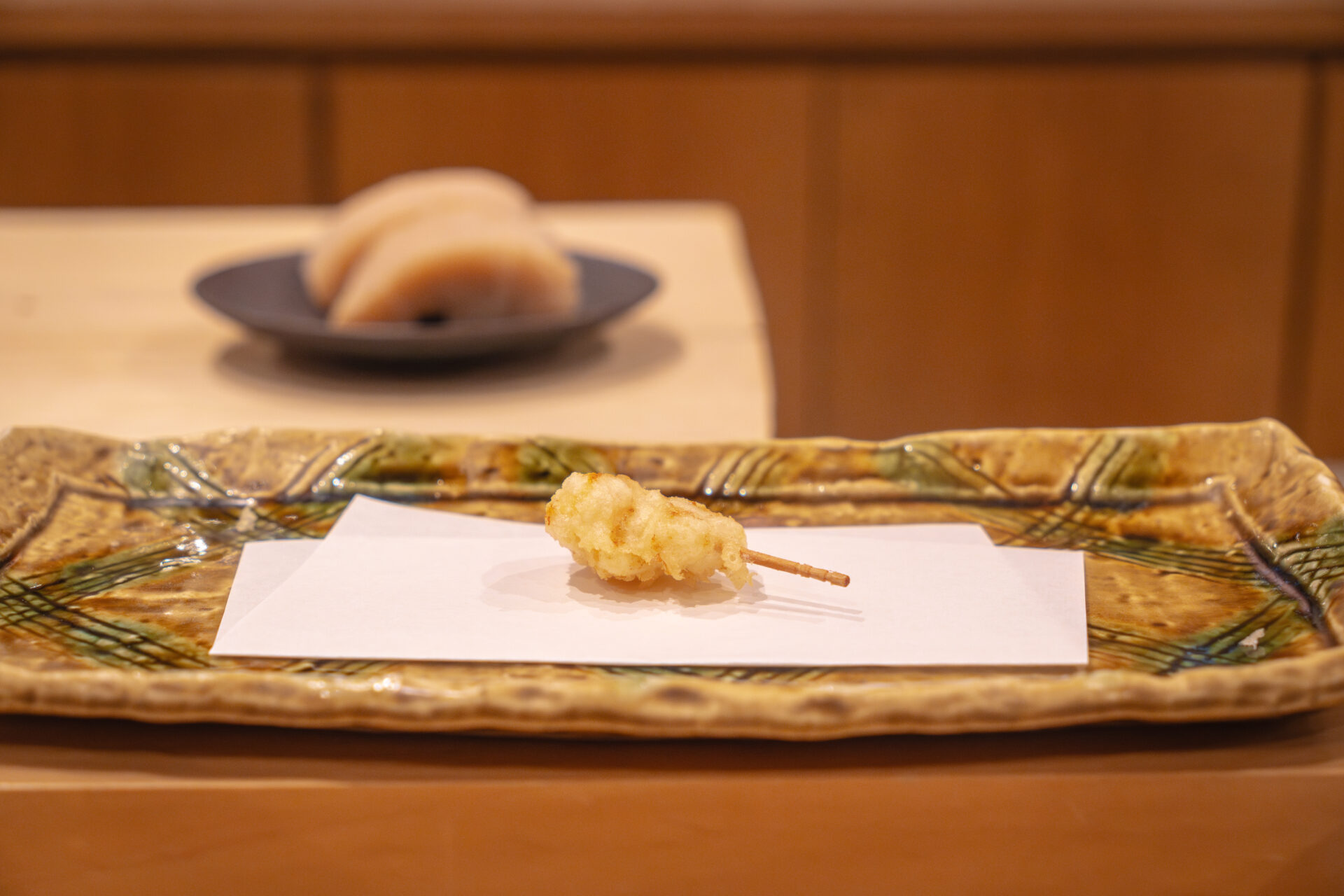
Tairagai (Pen Shell)
In the middle of the tempura course came a standout: tairagai (pen shell) tempura. Watching the chef meticulously slice the large scallop-like adductor muscle just across the counter conveyed the care behind each movement.
The entire plump muscle was fried whole, encased in a whisper-thin batter that allowed its natural elasticity and toasted fragrance to shine. With each bite, its gentle sweetness and deep umami slowly emerged—an exquisite result of precise temperature control.
Its textural balance and aromatic depth elevated the course’s rhythm, serving as a pivotal moment in the meal—quietly commanding, yet perfectly in step.
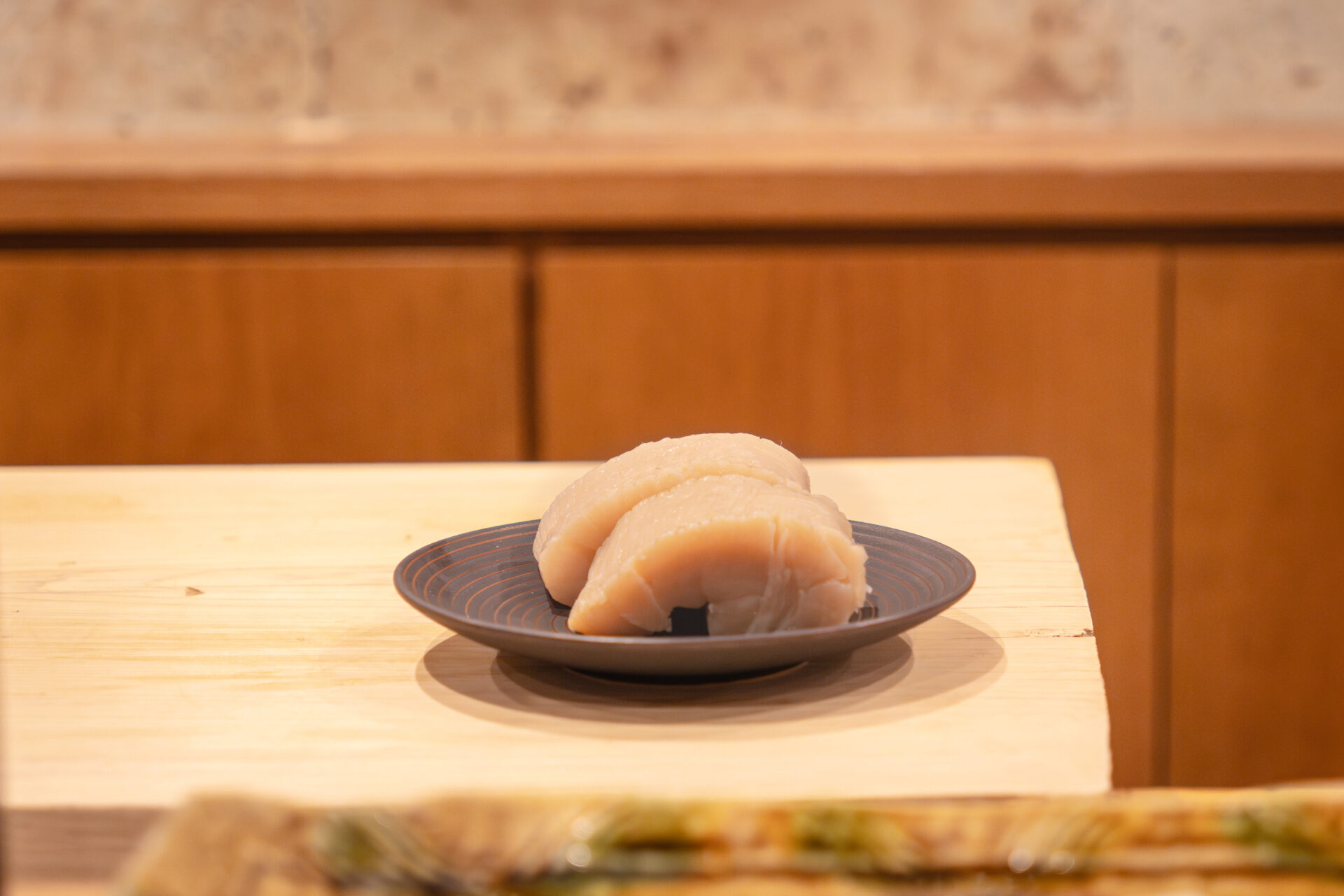
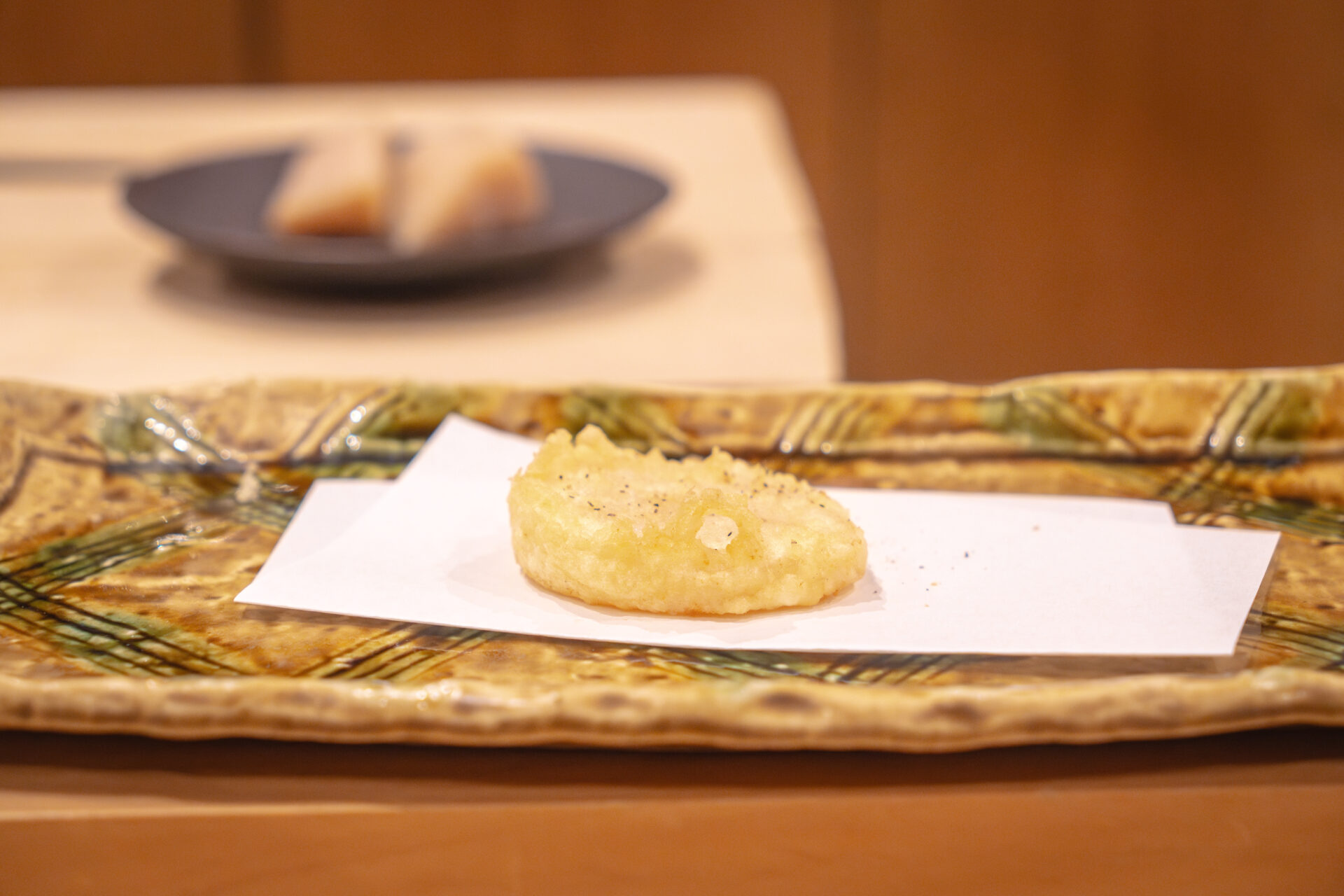
Shimaoka Shuzo “Hatsu Shibori”
Shimaoka Shuzo, a brewery in Ota, Gunma with over 150 years of history, is known for its unique neri-jikomi brewing method and dedication to crafting sake meant to accompany food.
This “Hatsu Shibori” (first pressing of the year) was a freshly pressed, vibrant sake. Its freshness, combined with a light effervescence and the round umami of rice, made for a refreshing and lively sip.
Fragrant like soft fruit, its crisp finish cut through the tempura’s oil gracefully—a sake that not only reset the palate, but enhanced the dining experience as a whole.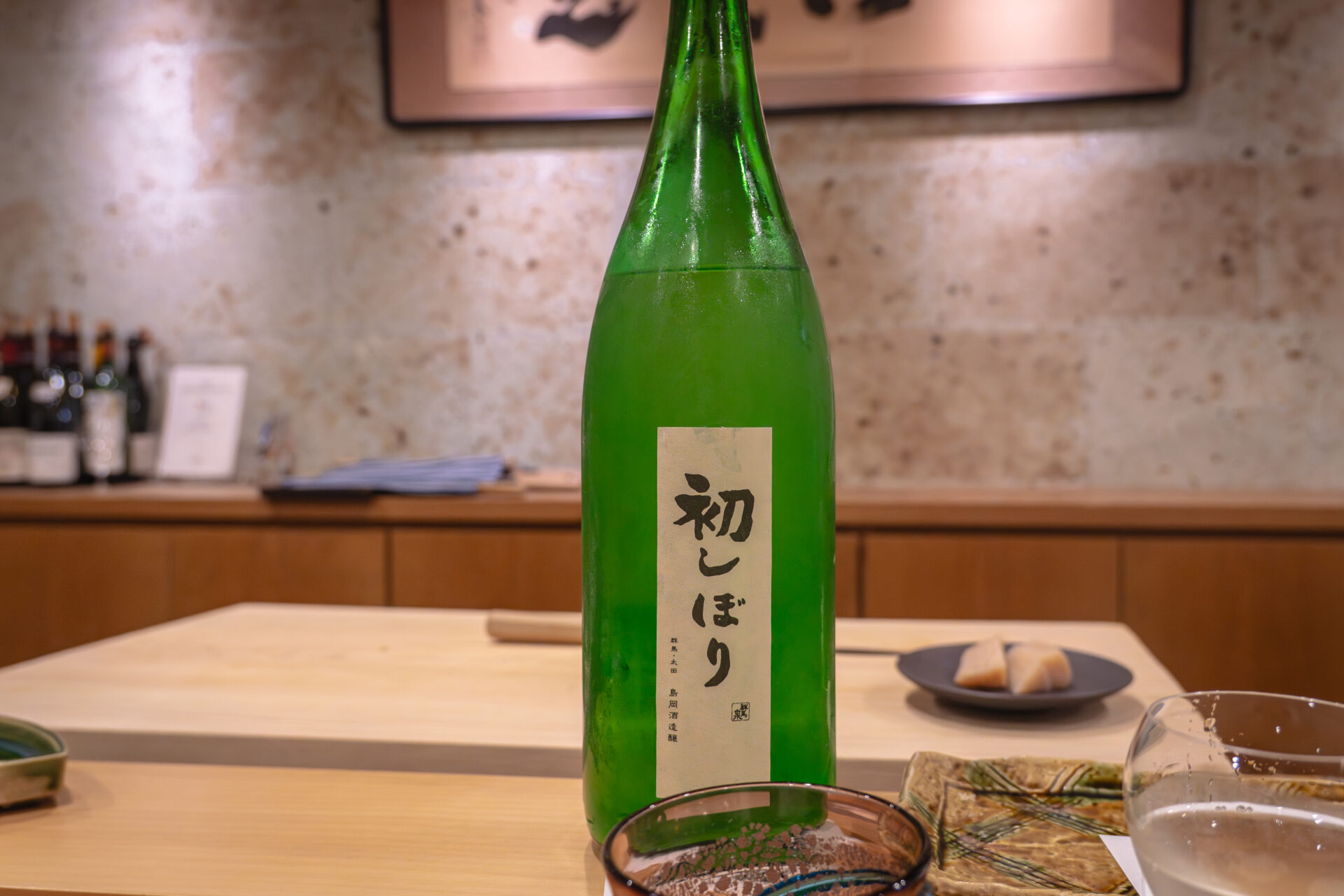
New Onion
As the course entered its latter half, a comforting yet memorable tempura of new onion made its appearance, grown by a friend of the chef.
Peeking from beneath its golden crust was a thick-cut wedge, caramelized and inviting. One bite released a burst of natural sweetness, with the heat coaxing out the vegetable’s fullest potential.
Unassuming yet quietly powerful, it reminded the diner how simplicity, when paired with care and craftsmanship, can be just as moving as any luxurious ingredient. It marked a turning point: “There’s still more to look forward to.”
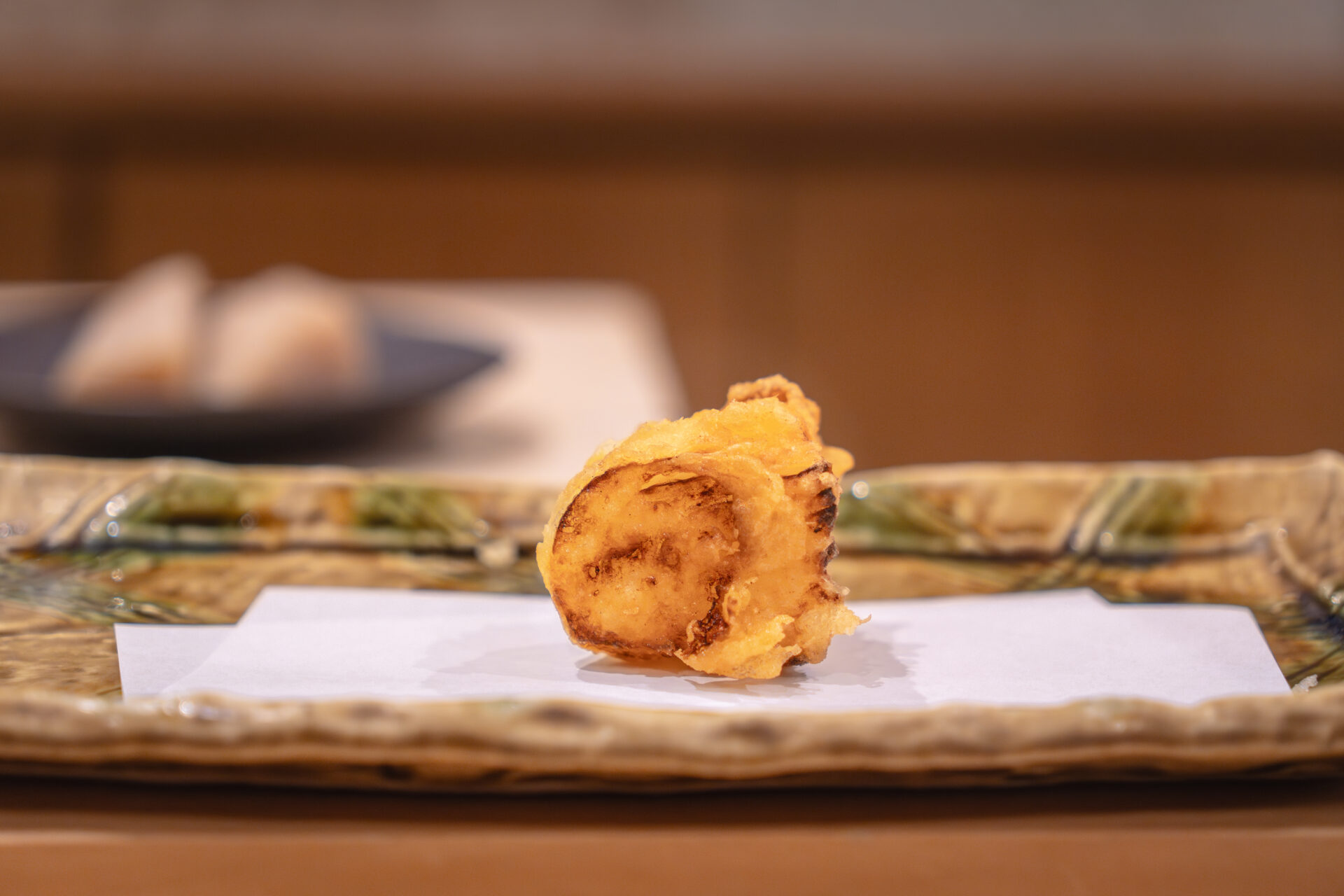
Palate Cleanser: Tomato
To gently reset the senses, a beautifully cut, glossy tomato was served.
Its balance of tartness and sweetness was pitch-perfect, its temperature neither too cold nor warm. Firm-fleshed and juicy, it almost resembled a ripe fruit more than a vegetable.
This single dish added contrast and dimensionality to the course—a quiet interlude that deepened the meal’s pacing and pleasure.
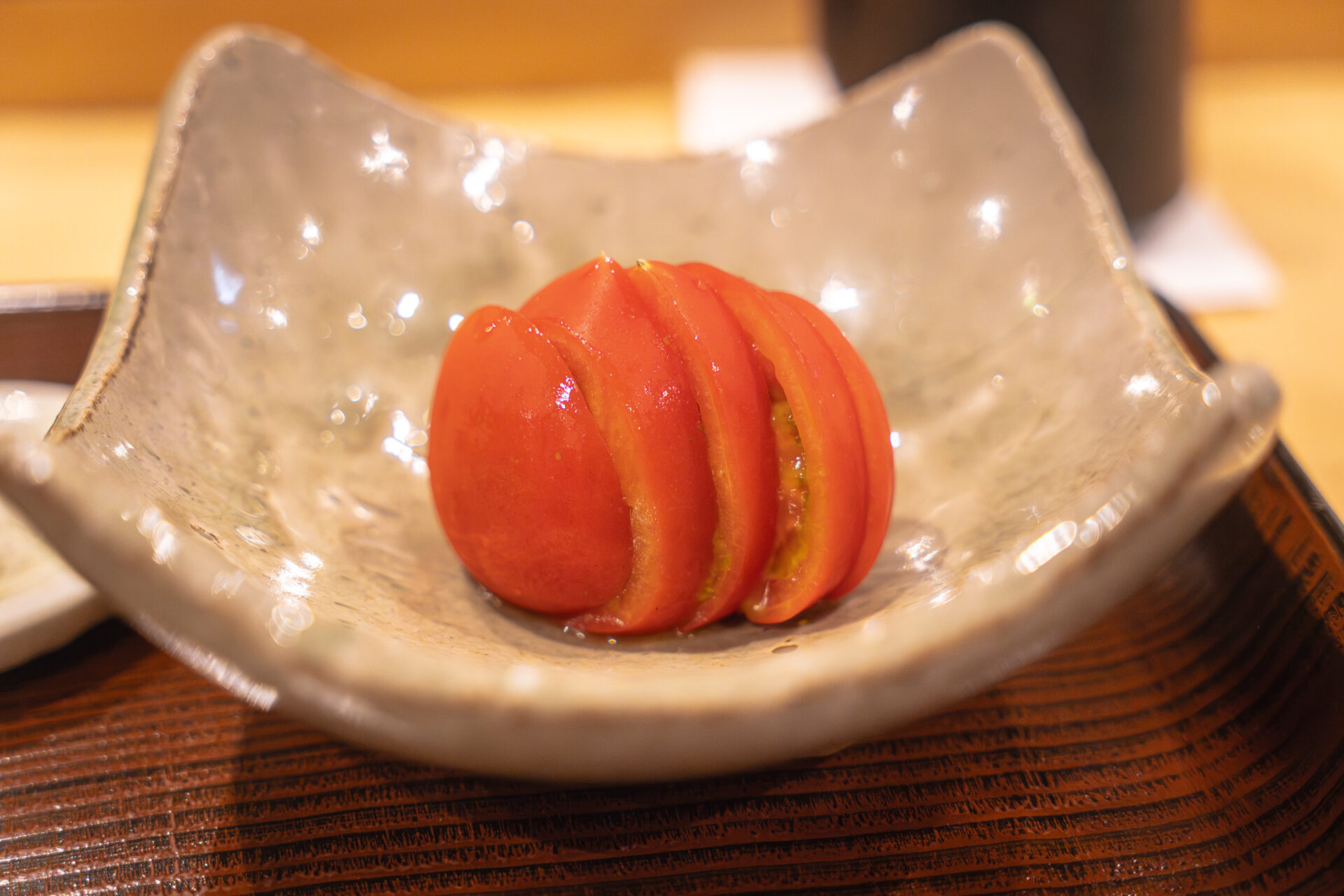
Tara-no-me (Angelica Tree Shoots)
As the tempura course neared its final stages, the “king of mountain vegetables”—tara-no-me—made its appearance.
Encased in a crisp, fragrant batter, it released a gentle bitterness and vibrant scent of spring with every bite. It was as if a scene from the mountain forest had momentarily entered the world of tempura.
Thick and hearty, each shoot was fully cooked through to the center, its contrasting textures perfectly preserved. A dish that highlighted the power of restraint, and the poetry of nature, through minimal intervention.
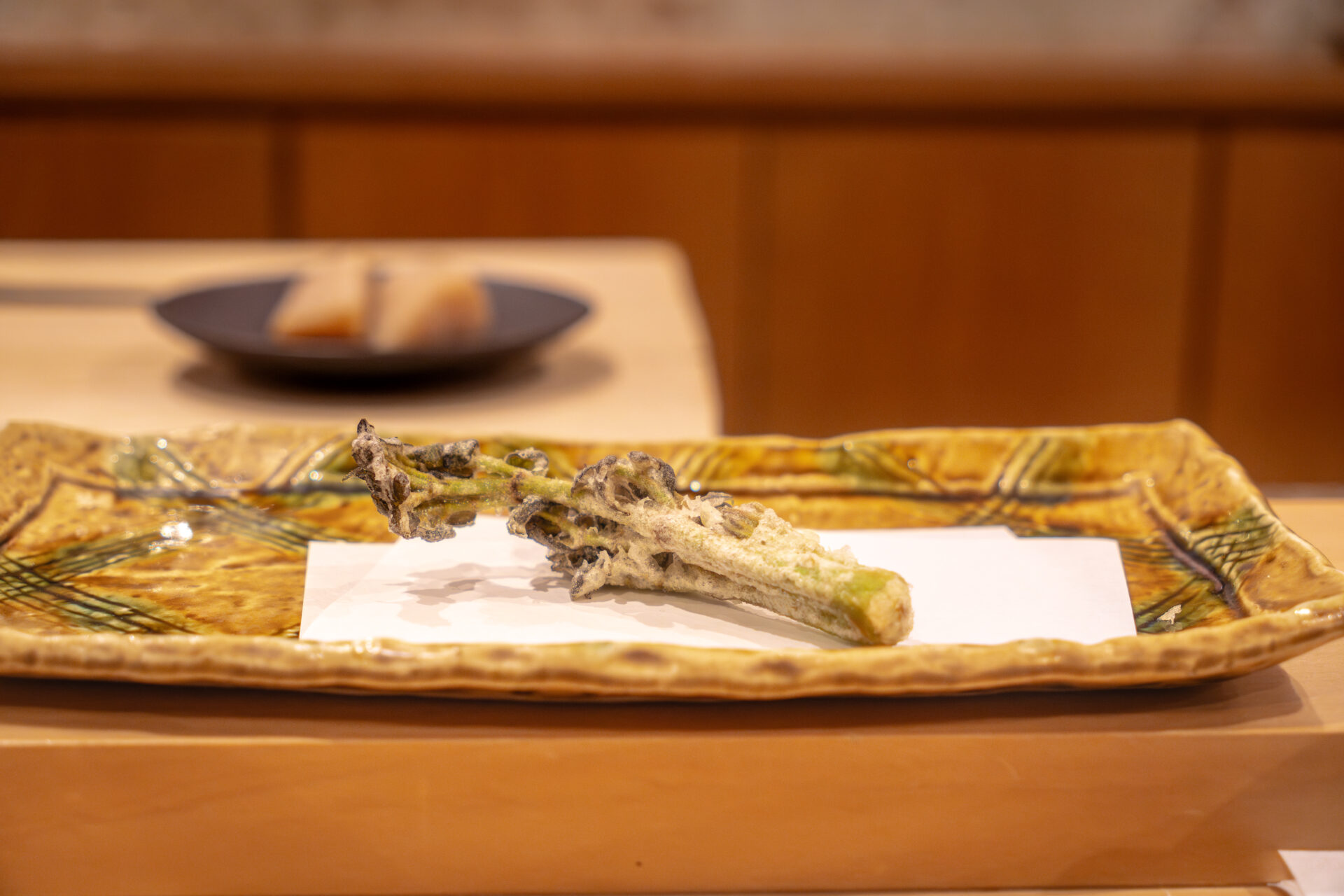
Mehikari (Greeneye Fish)
Later in the course, mehikari tempura arrived—a small, unassuming fish prized for its rich fat and melt-in-the-mouth texture.
Fried in a paper-thin batter to retain its soft fluffiness, it released a buttery sweetness and toasty aroma with the first bite, drawing an involuntary smile.
Delicate yet well-defined, it brought a deeper, rounder tone to the latter half of the course—an unforgettable expression of a lesser-known gem from the sea.
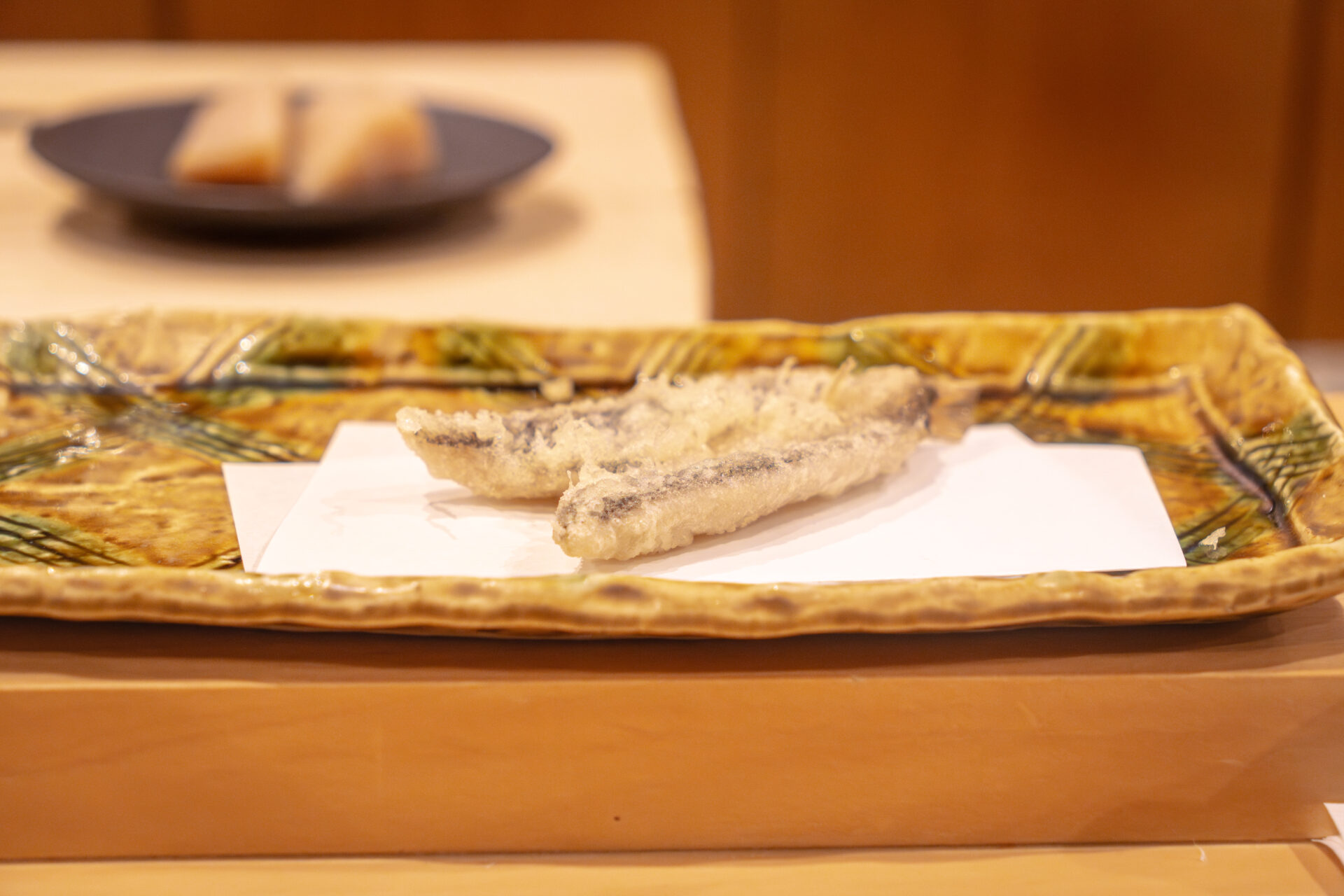
Anago (Sea Eel)
Approaching the climax, a full piece of anago (sea eel) was fried before the guest’s eyes. As the chef deftly split it with his chopsticks, fragrant steam rose and filled the air.
The batter was supremely light, the interior astonishingly fluffy. The tender flesh melted effortlessly, releasing sweet fat and umami that lingered softly on the tongue.
While grounded in the flow of the course, this dish brought a distinct lift—a dramatic crescendo worthy of the finale.
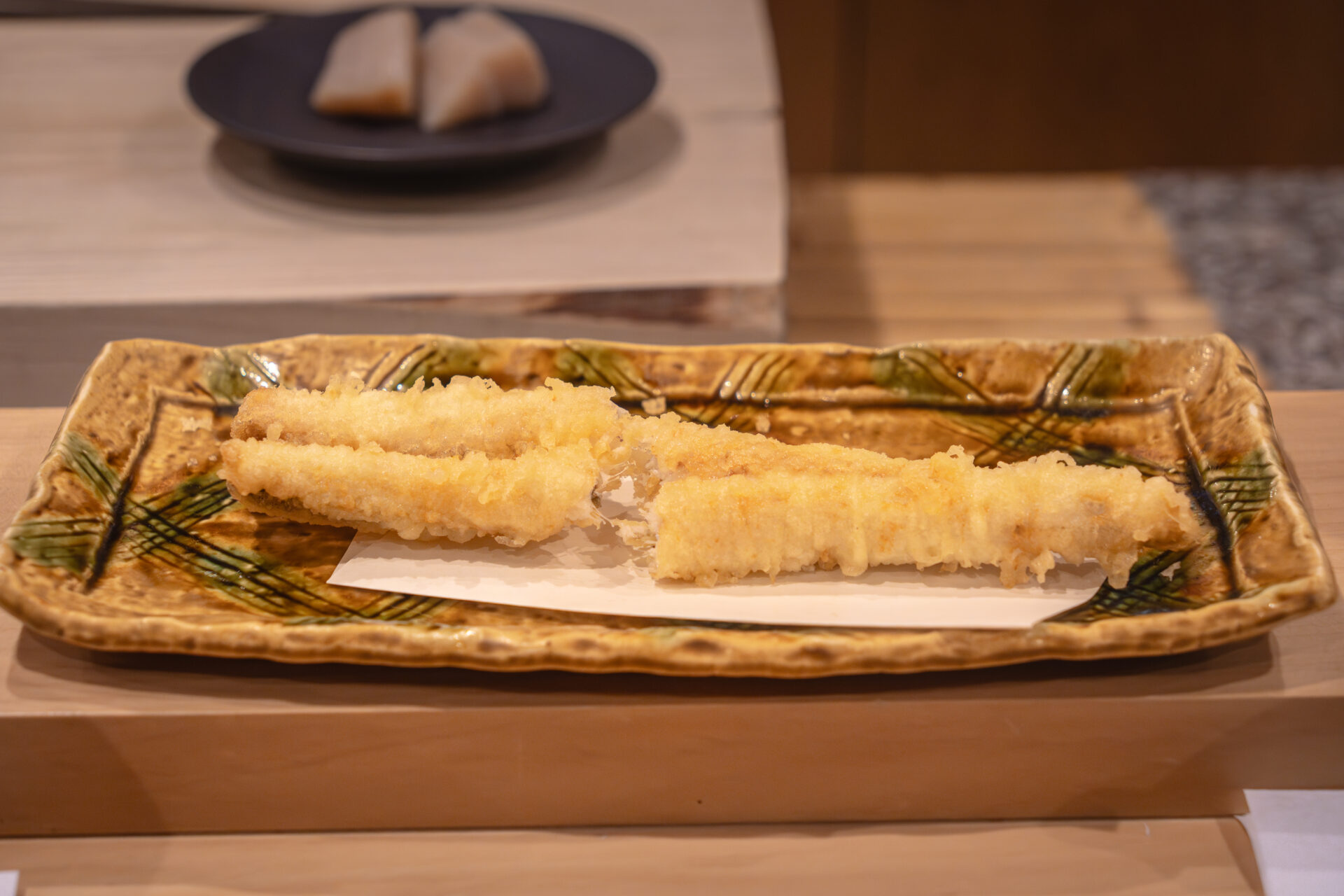
Kuruma Ebi Head
In a surprise move, the final bite of the meal was the head of the kuruma ebi, a dish usually seen earlier in a course.
Crisp and aromatic, each bite burst with concentrated shrimp umami, the toasted shell providing a satisfying crunch. It left behind the warm sweetness of crustacean in its purest, most distilled form—clean, never heavy.
This unexpected closer reflected the chef’s playfulness and confidence in the course’s arc. A striking final note—quietly bold, entirely memorable.
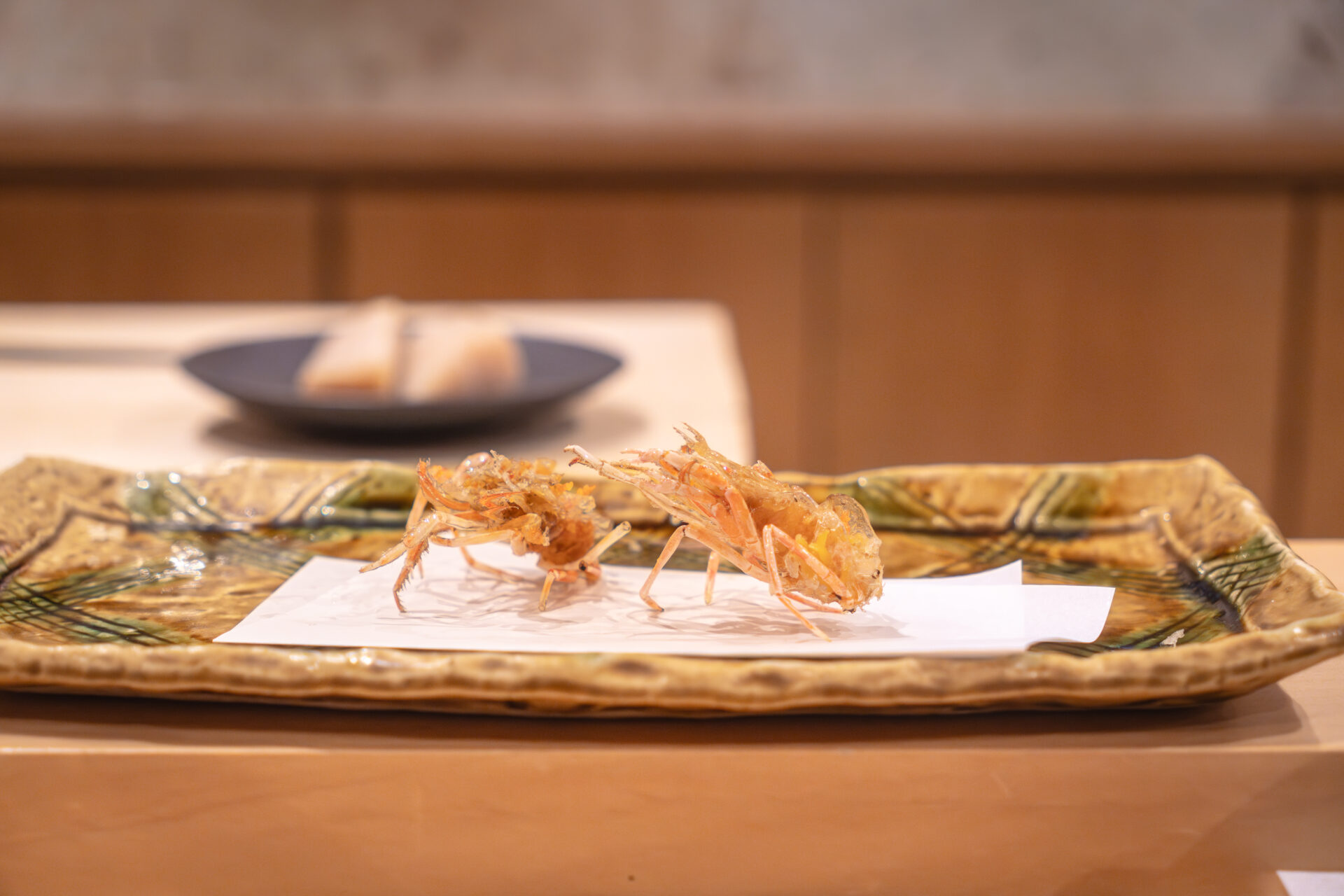
Homemade Ni-Hachi Soba with Nagano Buckwheat Flour
To conclude the tempura course, guests are served a bowl of house-made ni-hachi soba (80% buckwheat, 20% wheat), freshly prepared by the chef’s apprentice using high-quality buckwheat flour from Nagano.
Modest at first glance, the noodles release a fragrant aroma, offering both delicate resilience and smooth glide down the throat. The fine strands are tender and refreshing, washing away the richness of the tempura with a clean finish.
It’s a dish that speaks of refinement and restraint—showcasing not only the ingredient’s quality but also the unwavering focus and care that defines the entire course. Even at the end, the attention to detail remains impeccable.
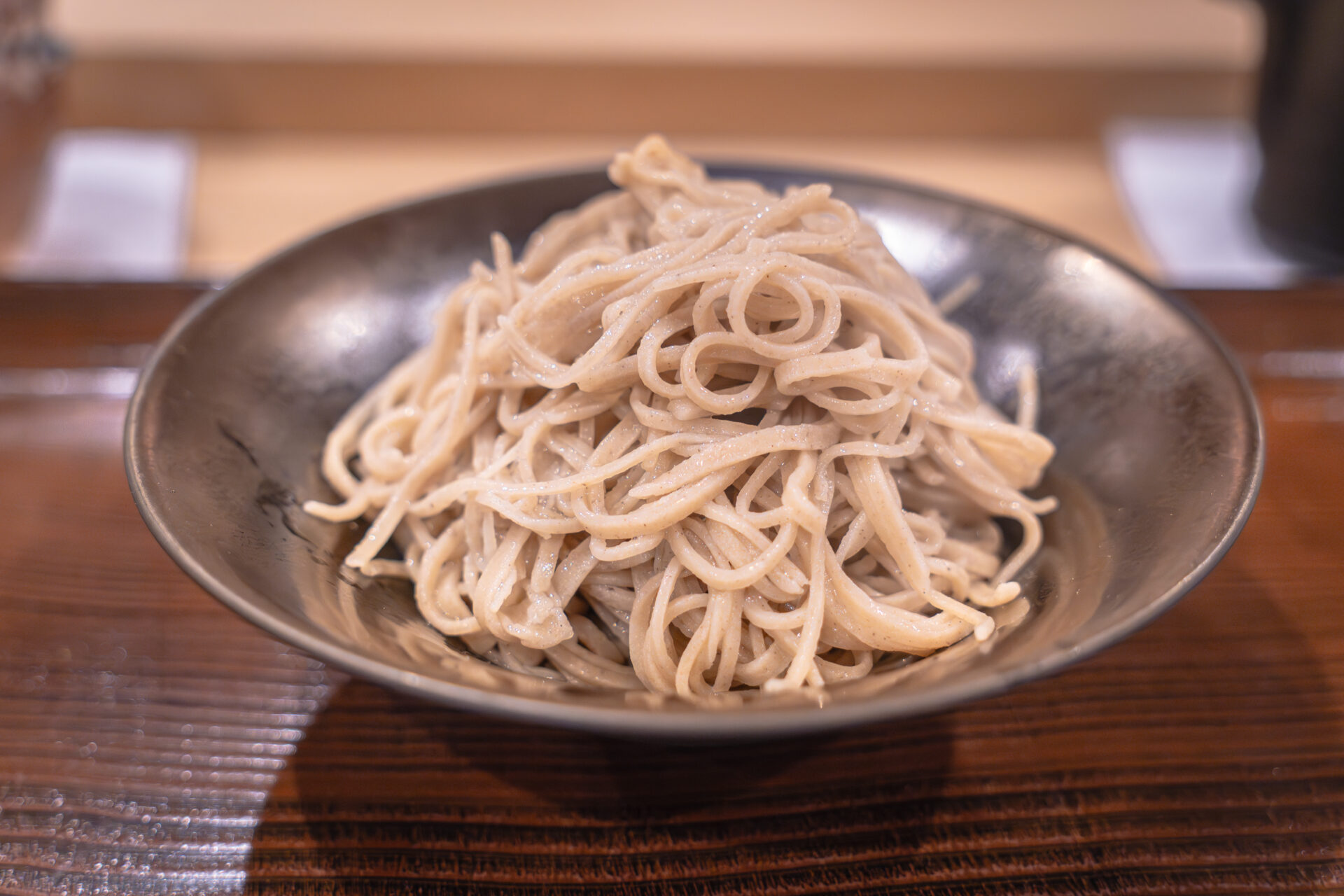
Mochi-Gatsuo Bara Chirashi & Clear Clam Soup
Making a delightful return, the mochi-gatsuo (extra-fresh katsuo) reappears—this time transformed into a vibrant bara chirashi (scattered sushi). Mixed with fragrant vinegared rice, cucumber, nori, and aromatics, the fish reveals a whole new personality.
Its rich fattiness pairs beautifully with the rice’s acidity and the lightness of the herbs, resulting in a dish that’s effortless to enjoy even at the meal’s close. By showcasing the same ingredient at both the beginning and end in such different forms, the chef invites guests to reflect on the ingredient’s full potential—an elegant, playful gesture.
Served alongside is a clear soup made from purely domestic Hamamatsu clams, renowned as a local heirloom variety with no history of hybridization. The broth is strikingly clear, yet brimming with the clams’ full-bodied umami, leaving a gentle, lingering finish.
It’s a bowl that invites quiet reflection—an expression not only of flavor but of story, place, and intention.
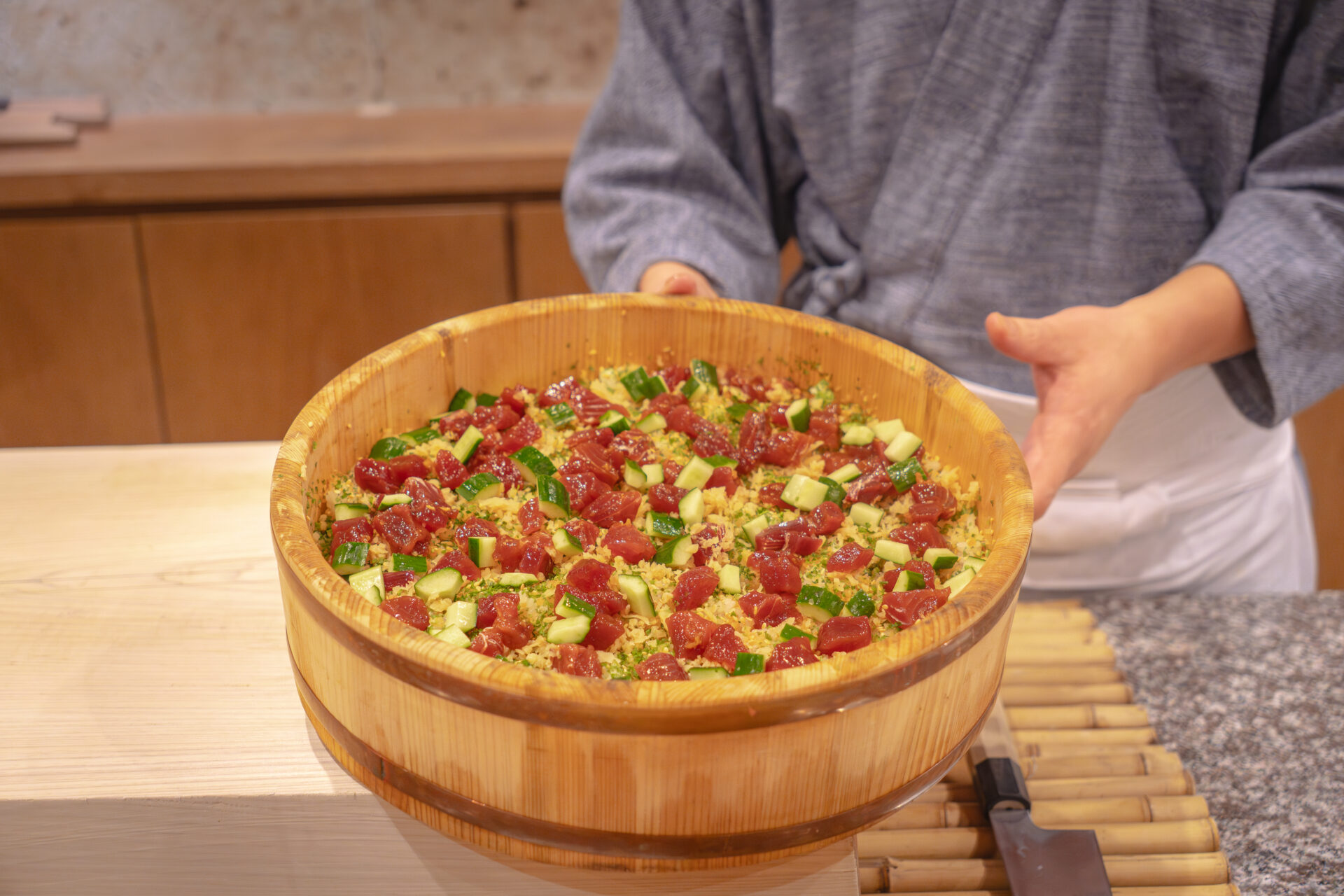
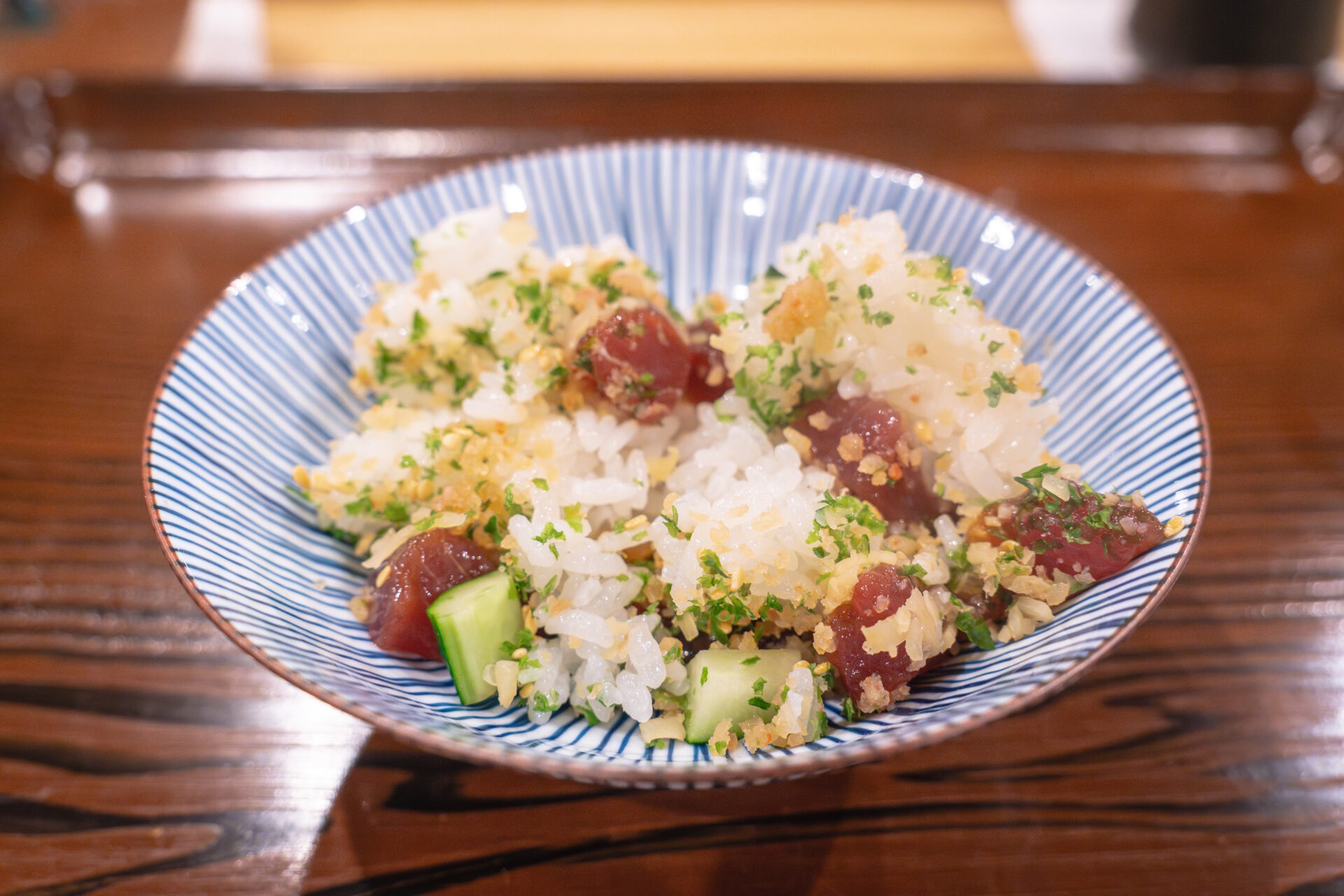
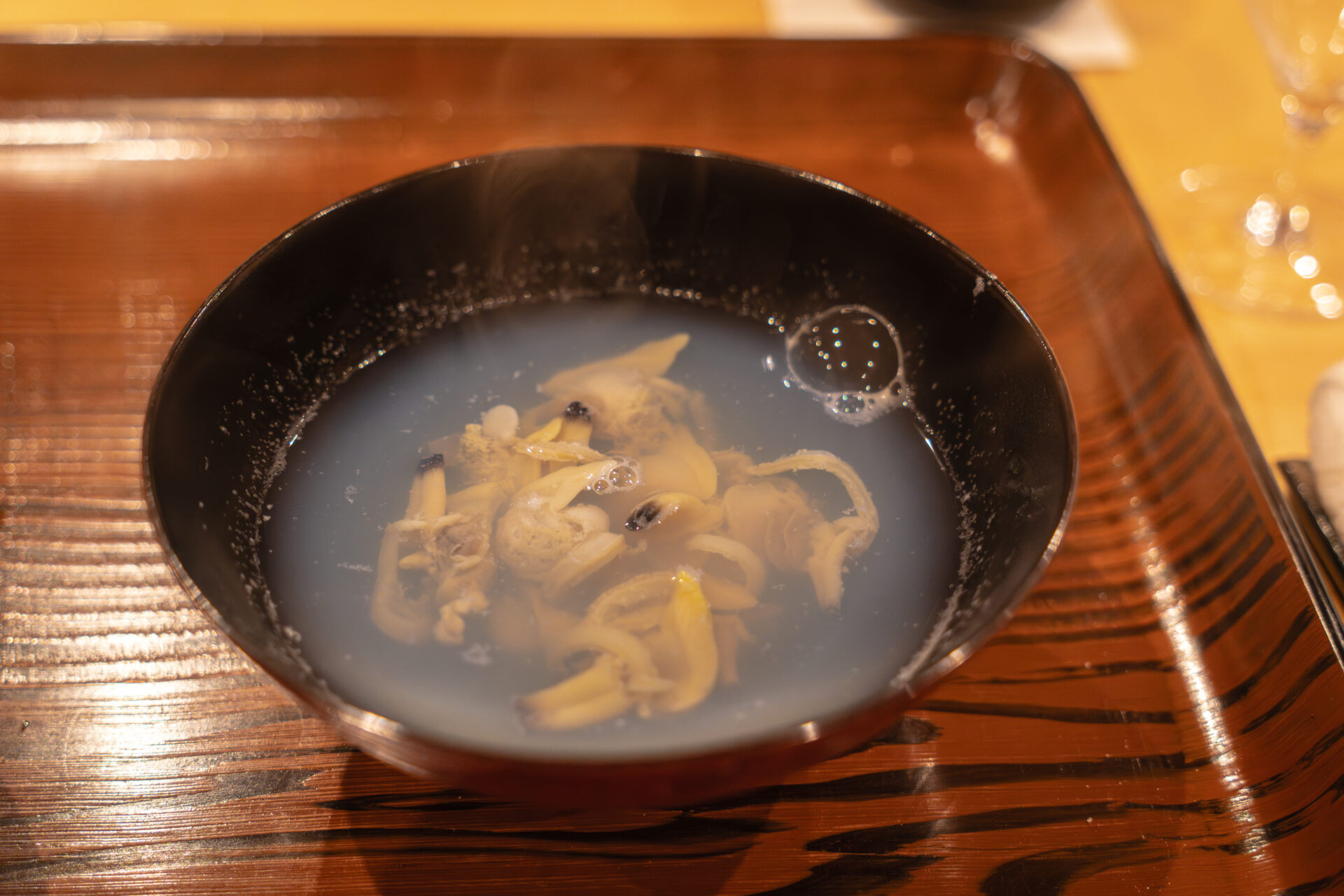
Dessert & Finale
Vacherin Glacé with Beni-Hoppe Strawberry
To close the evening, a vacherin glacé—a classic French dessert—arrives, reinterpreted with a distinctly Japanese sensibility.
Featuring Beni-Hoppe strawberries (a prized variety from Shizuoka), the tart-sweet sauce drapes over smooth, creamy ice cream. Layered between are crisp meringue pieces, adding texture and contrast.
What sets this dessert apart is its thoughtfully restrained sweetness: aside from the meringue, only honey is used—no sugar—lending a gentle, natural sweetness that lingers subtly.
It’s a dessert that maintains the spirit of classic French pastry while speaking softly in the language of Japanese seasonality and sensibility. A beautiful and understated finale.
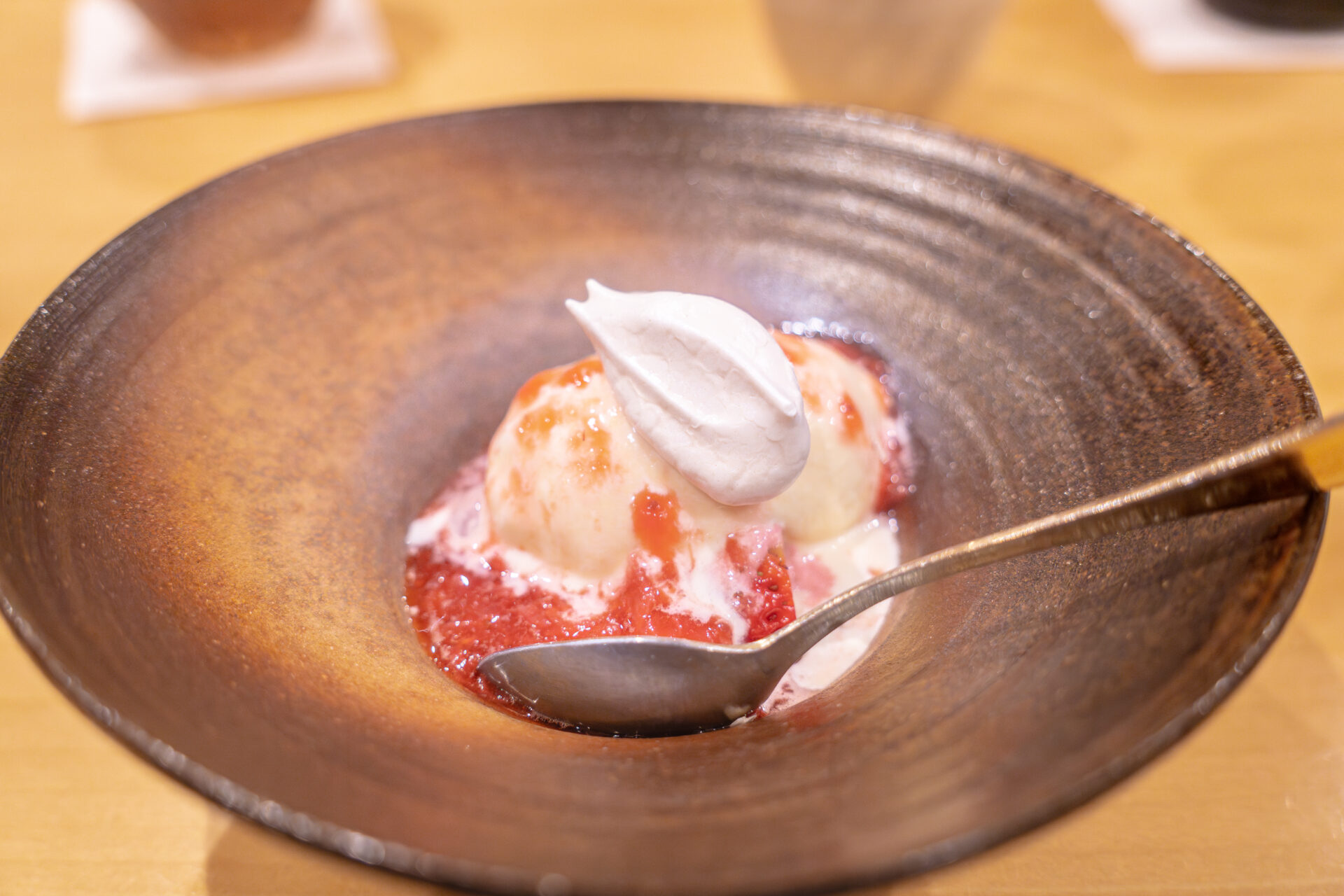
Reflections
At Seirin, the menu doesn’t just follow the seasons—it transforms with them, sometimes shifting from fugu to tempura, from hamo to wild eel, depending on the time of year. But this isn’t merely about showcasing seasonal ingredients. The restaurant’s form and focus change as a direct answer to one question:
“What is truly delicious here and now?”
With each dish fried before your eyes, the chef offers brief yet meaningful words—never excessive, never clinical—about the ingredient, its technique, or its story. This allows your attention to naturally center on the food itself.
Here, the phrase “not a ryōri-ya, but a tabemono-ya” takes shape. More than refined technique or theatrical presentation, what fills each plate is the quiet conclusion of countless thoughtful decisions on how to honor the ingredient and deliver it as pure “food.”
The restaurant’s expansion into yakitori, unagi, yakiniku, and even Chinese-style soba isn’t simply diversification—it’s an act of deepening and sustaining the local food culture of Hamamatsu. Each new venture becomes a means of cultivating the land and its traditions for future generations.
Though the names and appearances of each dish may fade from memory, what remains is this enduring feeling:
“I truly tasted what these people are making in this place.”
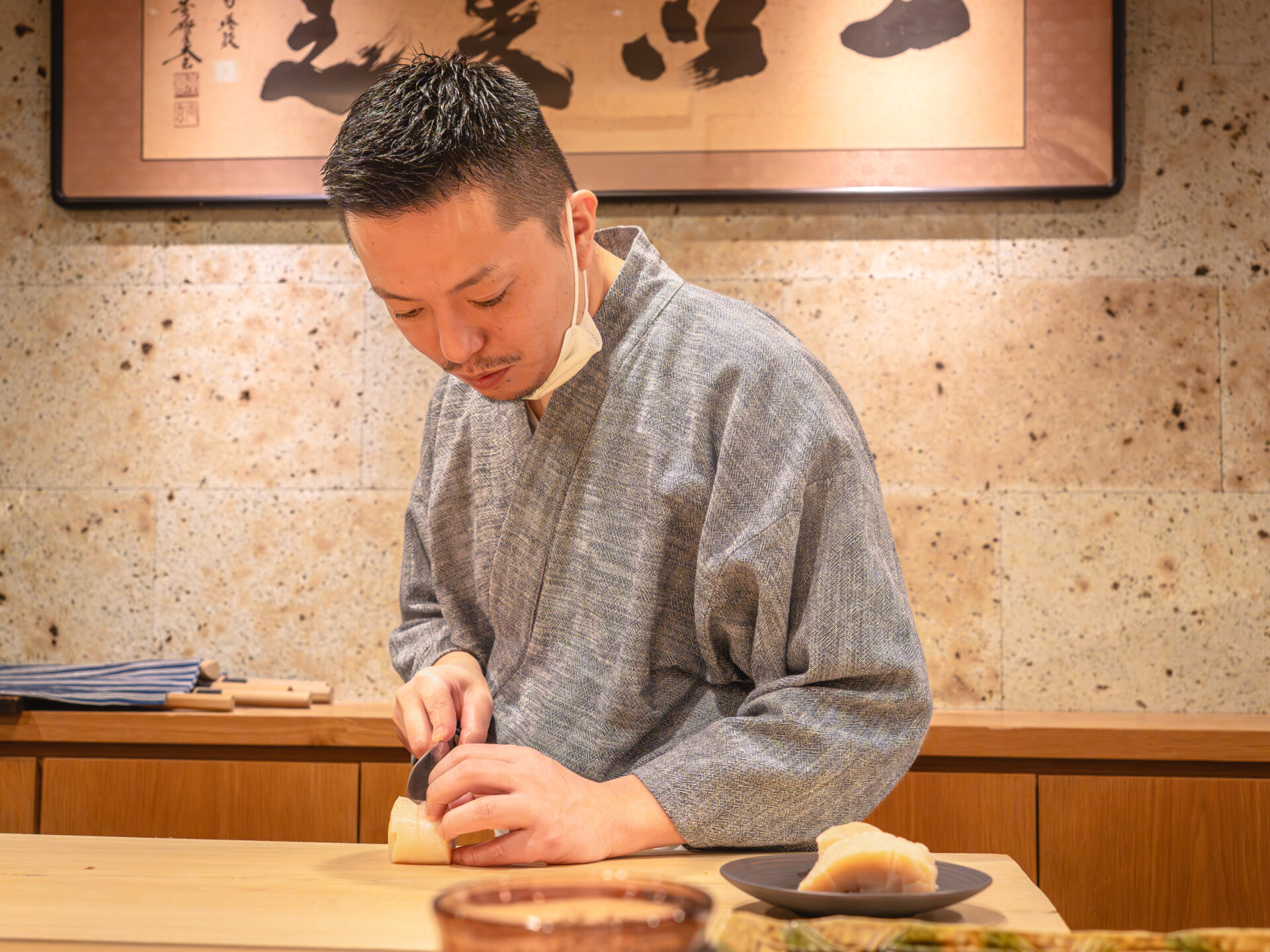
Reservation & Access Information
-
Address: 1F Ars Building, 222-25 Motojō-chō, Chūō-ku, Hamamatsu City, Shizuoka Prefecture
(Approx. 10-minute walk from JR Hamamatsu Station North Exit; 6-minute walk from Enshū Railway “Daiichi-dōri Station”) -
Hours: Dinner only — 6:00 PM start (two seatings, closes around 9:00 PM)
-
Closed: Irregular (check for temporary closures or extra service dates)
-
Seating: 8 counter seats (private reservations available)
-
Children: Guests must be 13+ and able to eat the full course
-
Reservations:
Strictly online via the “OMAKASE” platform.
Phone reservations not accepted. -
Price Range: ¥33,000–¥39,000 per person (tax included)
Varies by season and ingredients (e.g., fugu, matsutake, unagi) -
Cancellation Policy:
-
From time of booking: 5%
-
3 days before: 50%
-
Day before or same day: 100%
-
-
Payment: Cash and major credit cards (Visa, MasterCard, JCB, AmEx, Diners).
No e-money or QR code payment accepted. -
BYOB: Allowed, corkage fee ¥3,000 per bottle
Seasonal Focus by Period
-
Spring (April–May): Tempura-centric
-
Early Summer (June–July): Hamo-centered
-
Late Summer–Early Autumn (August–October): Wild unagi from Lake Hamana, matsutake, etc.
-
Winter (January–March): Fugu, game meats
Note: Course format may flexibly adapt to ingredient availability on the day of your visit.
- TAGS

